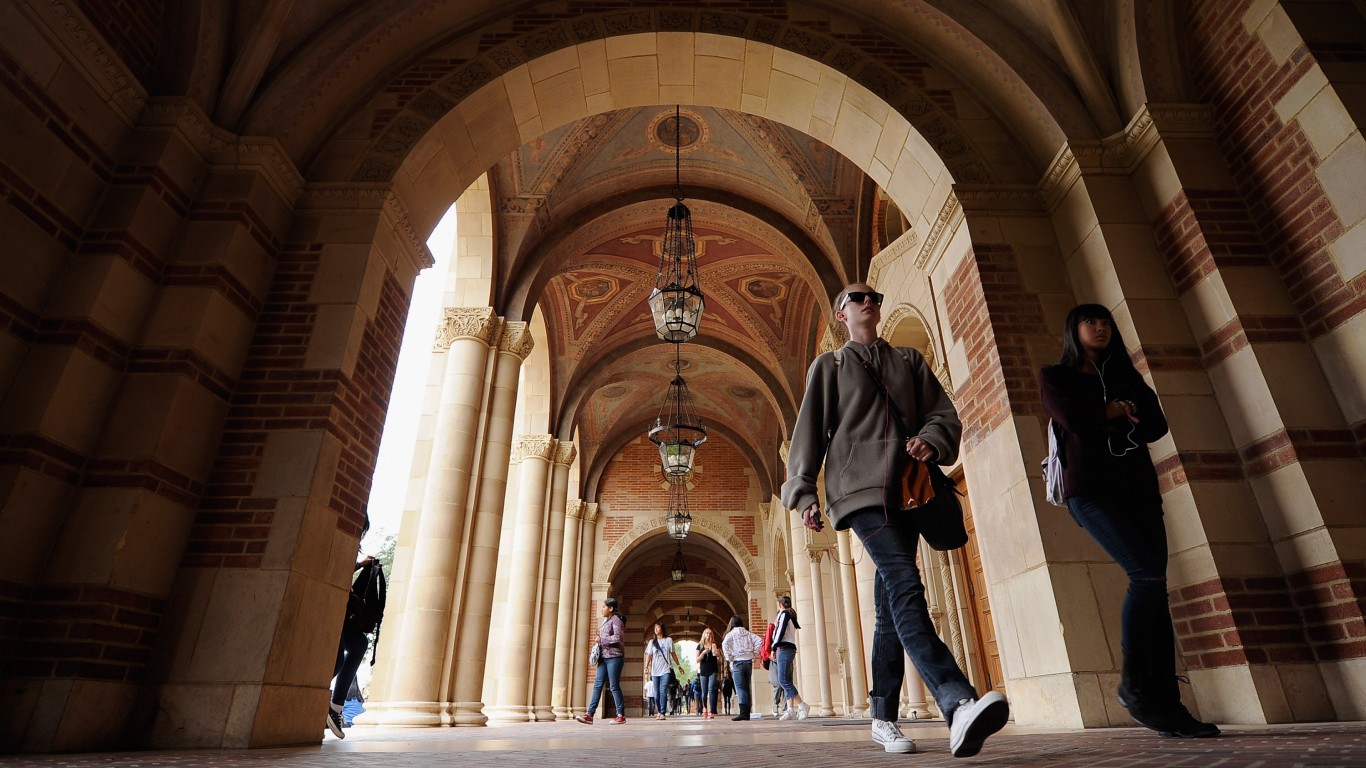

According to the Bureau of Labor Statistics, the typical American worker with a bachelor’s degree earns about $26,000 more per year than a worker with just a high school diploma. Additionally, the 2019 jobless rate among those who have completed college was 2.2% — compared to the 3.7% unemployment rate among those with no education beyond high school. The advantages can extend beyond the financial benefits, as higher educational attainment is also linked with better health outcomes.
Across the United States, 33.1% of the 25 and older population have a bachelor’s degree or higher. That share varies considerably from state to state and from city to city.
Using bachelor’s degree attainment rates at the metropolitan area level from the U.S. Census Bureau’s 2019 American Community Survey, 24/7 Wall St. identified the most educated city in every state. Four states — Delaware, New Hampshire, Rhode Island, and Vermont — are home to only one metro area. In these cases, the city on this list ranks as the most educated by default.
Major cities tend to have relatively high concentrations of college-educated residents. Not surprisingly, nearly every metro area on this list is home to a larger share of adults with at least a bachelor’s degree than the state as a whole. Because high incomes tend to correspond with higher levels of educational attainment, most metro areas on this list have a higher median household income than the state they are located in. Here is a look at the richest town in every state.
Click here to see the most educated city in every state
Click here to read our methodology
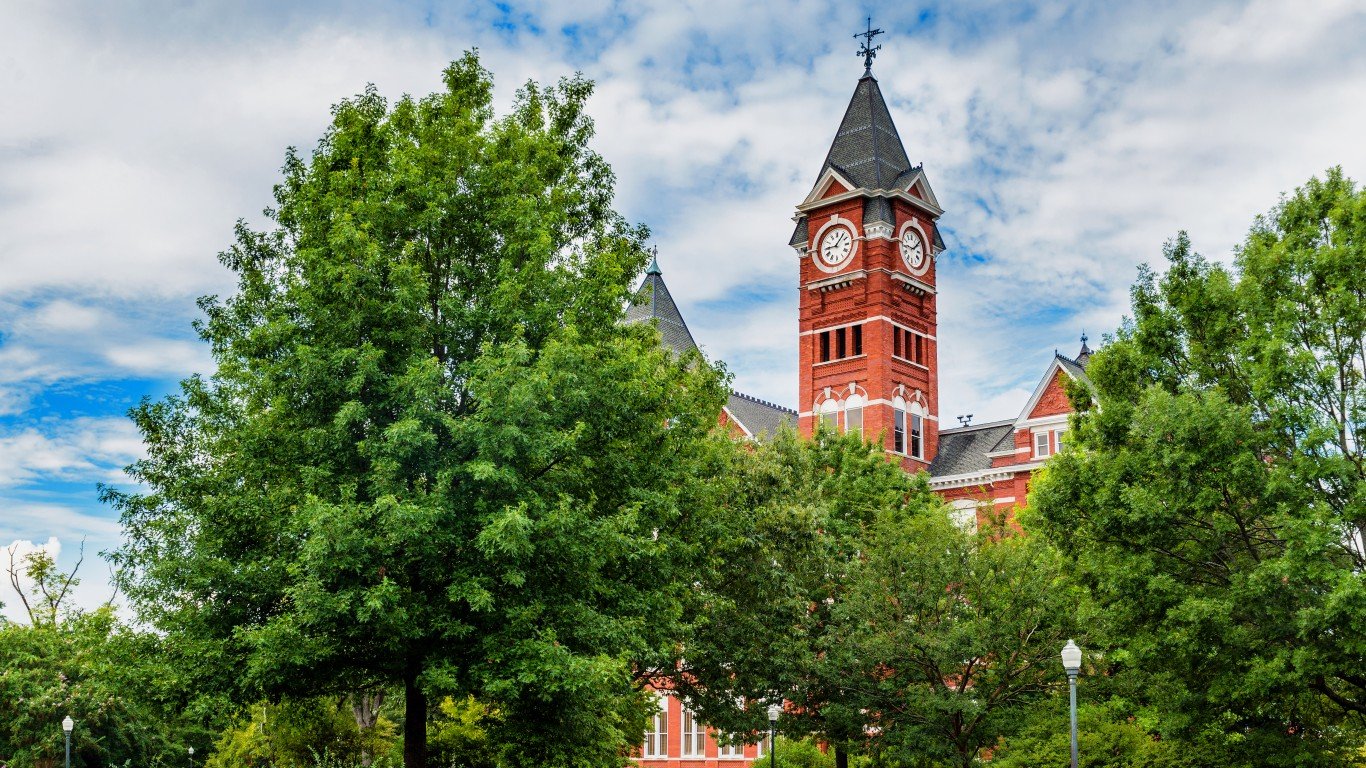
Alabama: Auburn-Opelika
> Adults with a bachelor’s degree: 41.4% (state: 26.3%)
> Median household income: $53,712 (state: $51,734)
> Number of college and universities: 1
The Auburn-Opelika metro area is home to Auburn University, the second largest higher learning institution in Alabama with an enrollment of nearly 25,000. Such a large university requires many college-educated workers and is likely a major reason for the area’s high share of adults with at least a bachelor’s degree, at 41.4%. To compare, 26.3% of adults across Alabama and 33.1% of adults nationwide hold at least a bachelor’s degree.
Applicants with a college degree are often more suitable as well as more desirable to a larger range of jobs, and areas with higher education attainment rates often have lower unemployment. Similarly, the area’s median household income is nearly $2,000 higher than the median income statewide.
[in-text-ad]
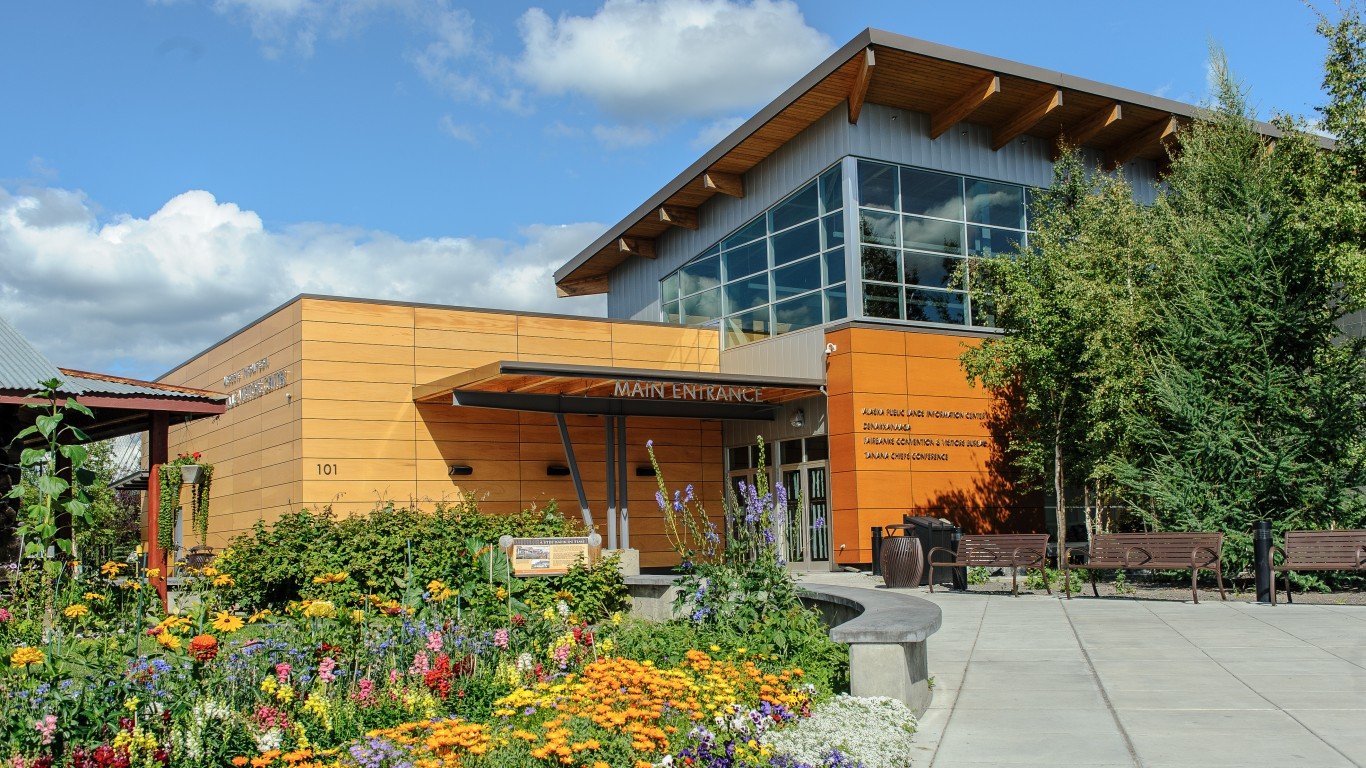
Alaska: Fairbanks
> Adults with a bachelor’s degree: 33.3% (state: 30.2%)
> Median household income: $72,065 (state: $75,463)
> Number of college and universities: 2
Of Alaska’s two metro areas, Fairbanks has the more educated population with a third of adults holding at least a bachelor’s degree, narrowly edging out Anchorage and its 33.1% bachelor’s degree attainment rate. The University of Alaska Fairbanks had more than 8,000 students enrolled in 2019 between its main campus and its Community and Technical College — 12% of whom were enrolled in graduate programs.
Unlike most other states, Alaska’s most educated city does not have especially high incomes compared to the state as a whole. In fact, the median household income in Fairbanks is over $3,000 below Alaska’s median household income.

Arizona: Flagstaff
> Adults with a bachelor’s degree: 39.6% (state: 30.2%)
> Median household income: $58,085 (state: $62,055)
> Number of college and universities: 4
Areas with high educational attainment often have lower than average unemployment. However, Flagstaff — the most educated metro area in Arizona with a bachelor’s degree attainment rate of 39.6% — is an exception. The city’s July unemployment rate of 13.2% is higher than the state jobless rate of 10.6% and the national rate of 10.2%. Largely due to reasons tied to the COVID-19 pandemic, unemployment rates are more than double what they were at the same time a year ago.
The median annual household income in Flagstaff is lower than the state’s median of $62,055, which is itself lower than the national median of $65,712.
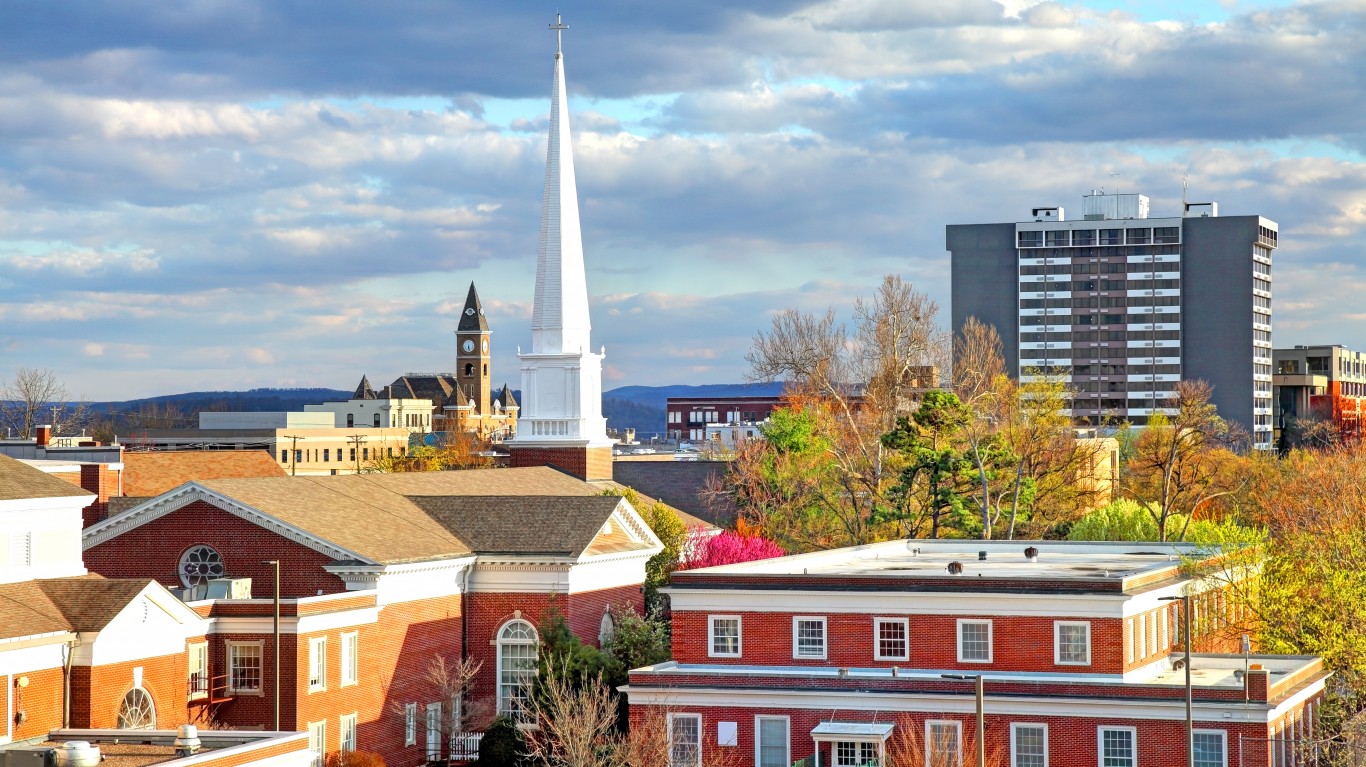
Arkansas: Fayetteville-Springdale-Rogers
> Adults with a bachelor’s degree: 33% (state: 23.3%)
> Median household income: $61,674 (state: $48,952)
> Number of college and universities: 10
Just 23.3% of adults in Arkansas have a bachelor’s degree, one of the smallest shares of any state. In Fayetteville, the most educated metro area in the state, 33.1% of adults have at least a four-year college degree, in line with the 33.1% of adults who do nationwide.
Incomes tend to rise with educational attainment levels, and in Fayetteville, the typical household earns $61,674 a year — less than the national median household income of $65,712 but well above the statewide median of $48,952.
[in-text-ad-2]
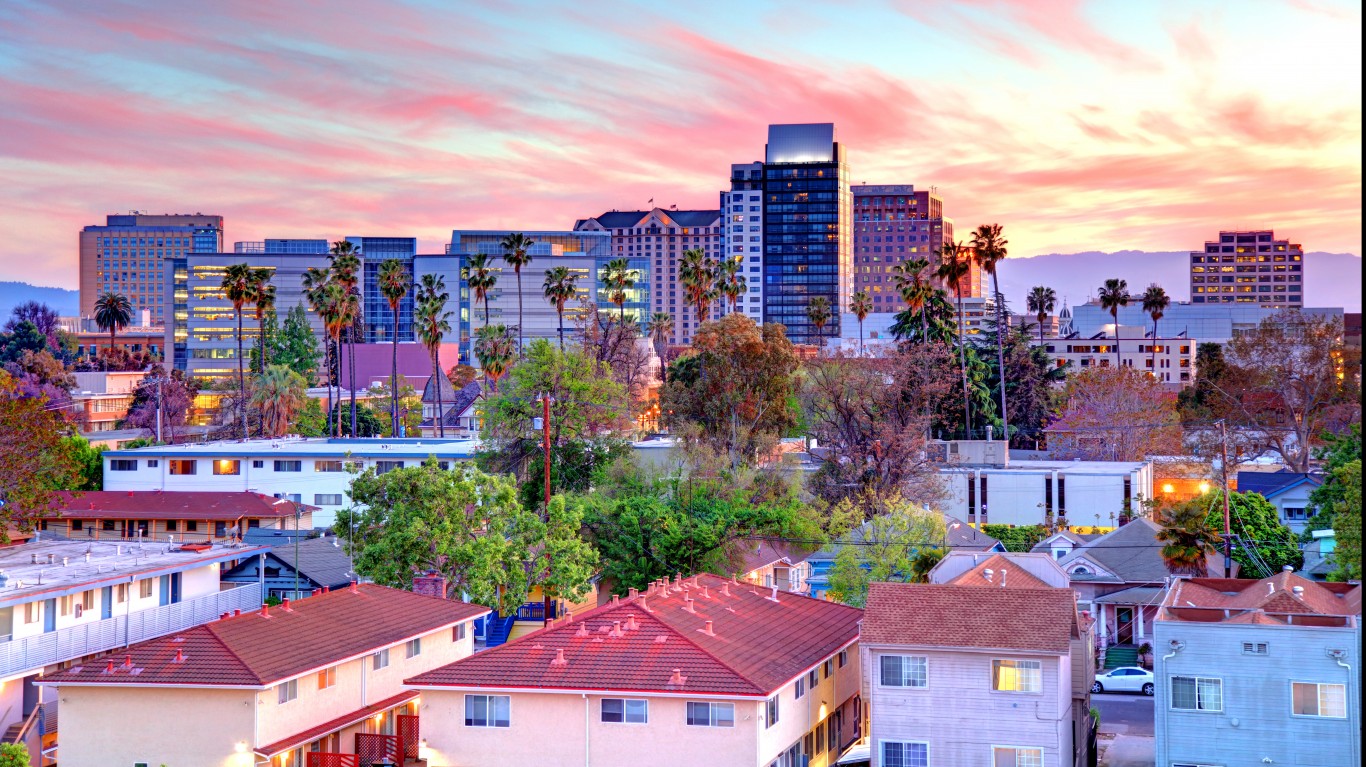
California: San Jose-Sunnyvale-Santa Clara
> Adults with a bachelor’s degree: 52.7% (state: 35.0%)
> Median household income: $130,865 (state: $80,440)
> Number of college and universities: 26
San Jose-Sunnyvale-Santa Clara is one of only seven metro areas in the United States where more than half of adults hold at least a bachelor’s degree. The high educational attainment is likely related to the composition of the area’s job market. The metro area covers much of Silicon Valley, a tech hub home to companies like Apple, Facebook, and Google. The high educational attainment and a large tech sector help drive the high median household income in San Jose.
The typical San Jose household has an income of $130,865 a year, the highest of any metro area in the country and more than twice the national median of $65,712.
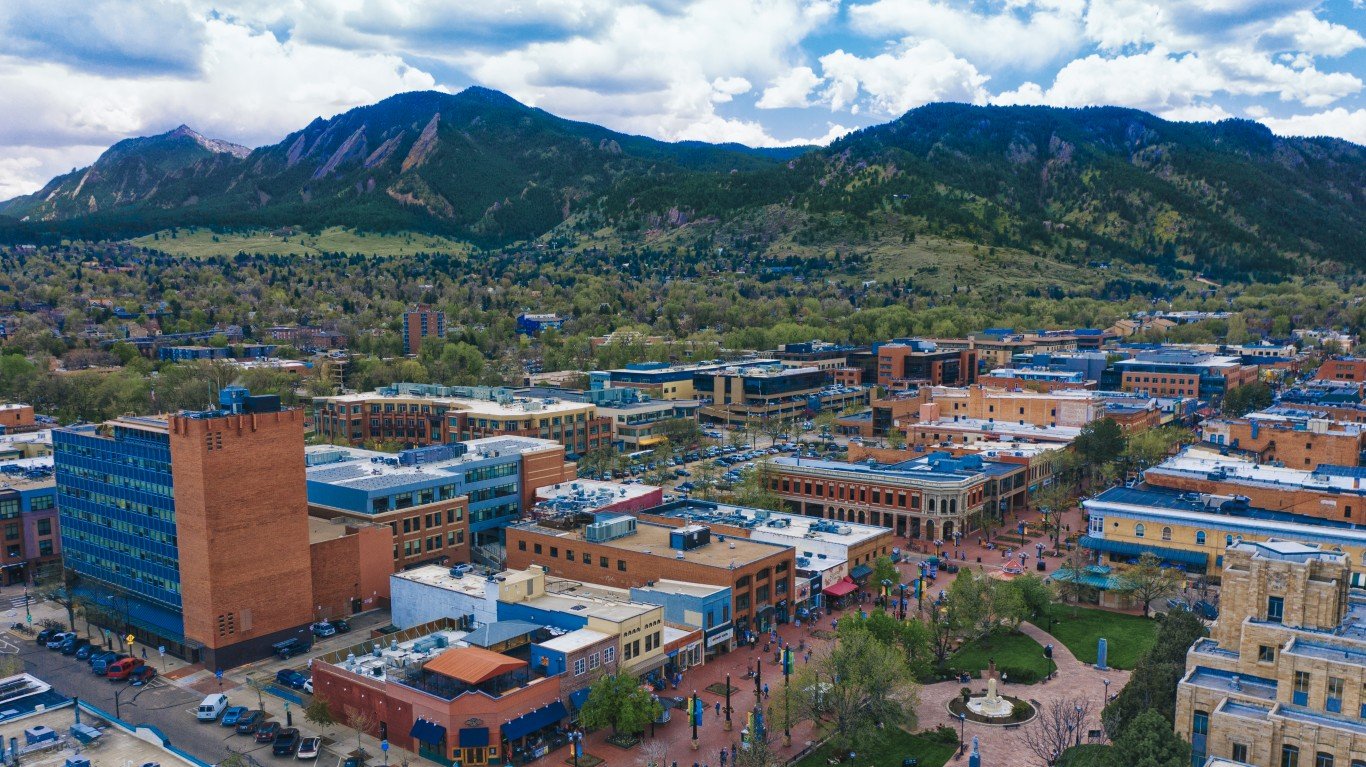
Colorado: Boulder
> Adults with a bachelor’s degree: 64.8% (state: 42.7%)
> Median household income: $88,535 (state: $77,127)
> Number of college and universities: 8
Boulder is the best educated metro area in both Colorado and the United States. Some 64.8% of metro area adults have a bachelor’s degree or higher, compared to 42.7% of adults in Colorado and 33.1% of adults nationwide.
College-educated adults tend to have far better access to good, stable jobs compared to those with only a high school diploma. The Boulder metropolitan area, with its high level of educational attainment, has relatively low unemployment. The area’s 6.4% unemployment rate is lower than the state and national unemployment rates of 7.4% and 10.2%, respectively. Like nearly everywhere nationwide, jobless rates in Boulder and Colorado are far higher than they were a year ago due in large part to the recession brought on by the coronavirus pandemic.
[in-text-ad]

Connecticut: Bridgeport-Stamford-Norwalk
> Adults with a bachelor’s degree: 49.1% (state: 39.8%)
> Median household income: $97,053 (state: $78,833)
> Number of college and universities: 19
Connecticut has one of the most highly educated populations in the country, with a bachelor’s degree attainment rate of 39.6%. Each of the four metro areas in the state is home to a larger share of college-educated adults than the 33.1% national share.
In the Bridgeport metro area, 49.1% of adults have at least a four-year degree, the largest share in the state and 10th largest of the nation’s 384 metropolitan areas. Incomes tend to rise with educational attainment, and in Bridgeport, the typical household earns $97,053 a year, the most of any Connecticut metro area and well above the median annual household income of $78,833 statewide.
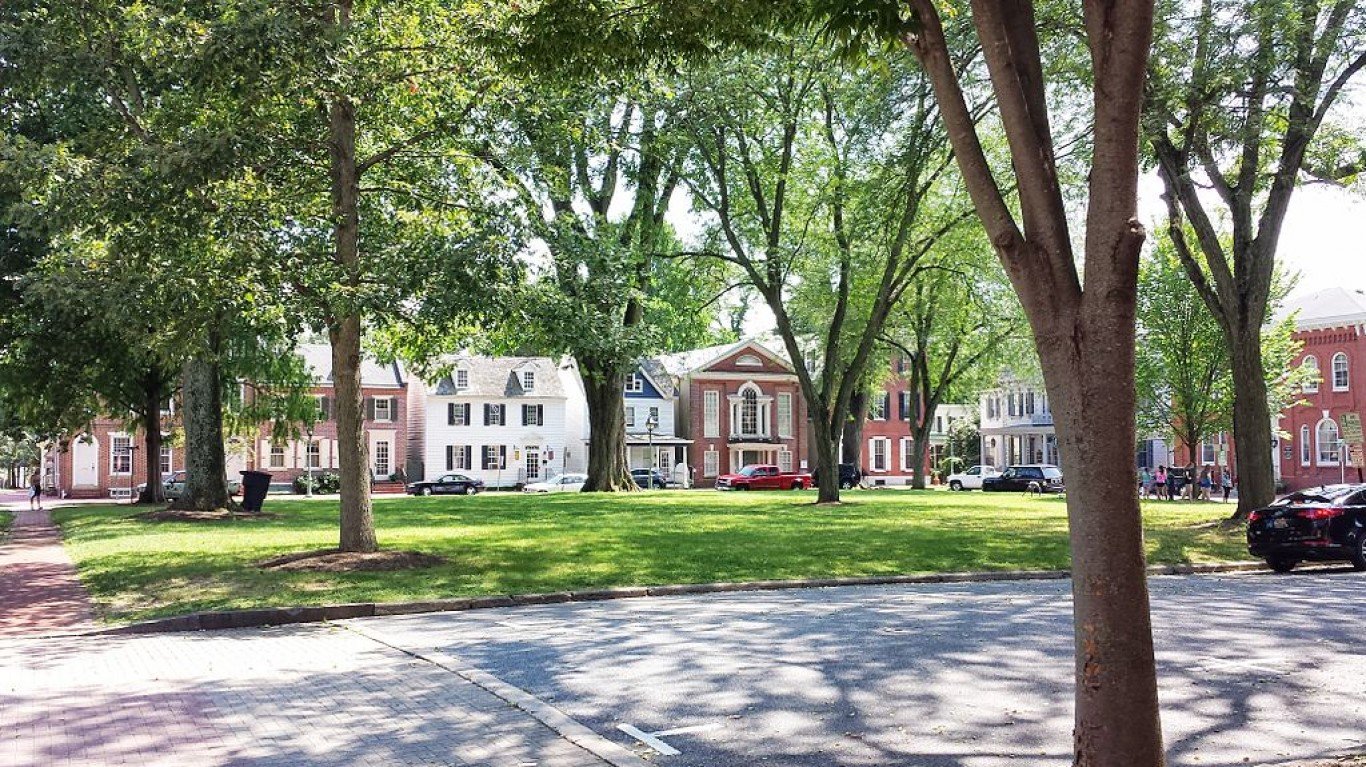
Delaware: Dover
> Adults with a bachelor’s degree: 24.5% (state: 33.2%)
> Median household income: $58,001 (state: $70,176)
> Number of college and universities: 5
Less than a quarter of Dover adults 25 and older hold a bachelor’s degree, well below the nationwide college degree attainment rate of 33.1% and the statewide rate of 33.2%.
Because Dover is the only major metropolitan area in Delaware, it still ranks as the state’s most educated city by default. Like many other cities with lower college degree attainment rates than the national average, Dover has a relatively low median household income. The typical metro area household earns just $58,001, which is about $7,500 below the national median.
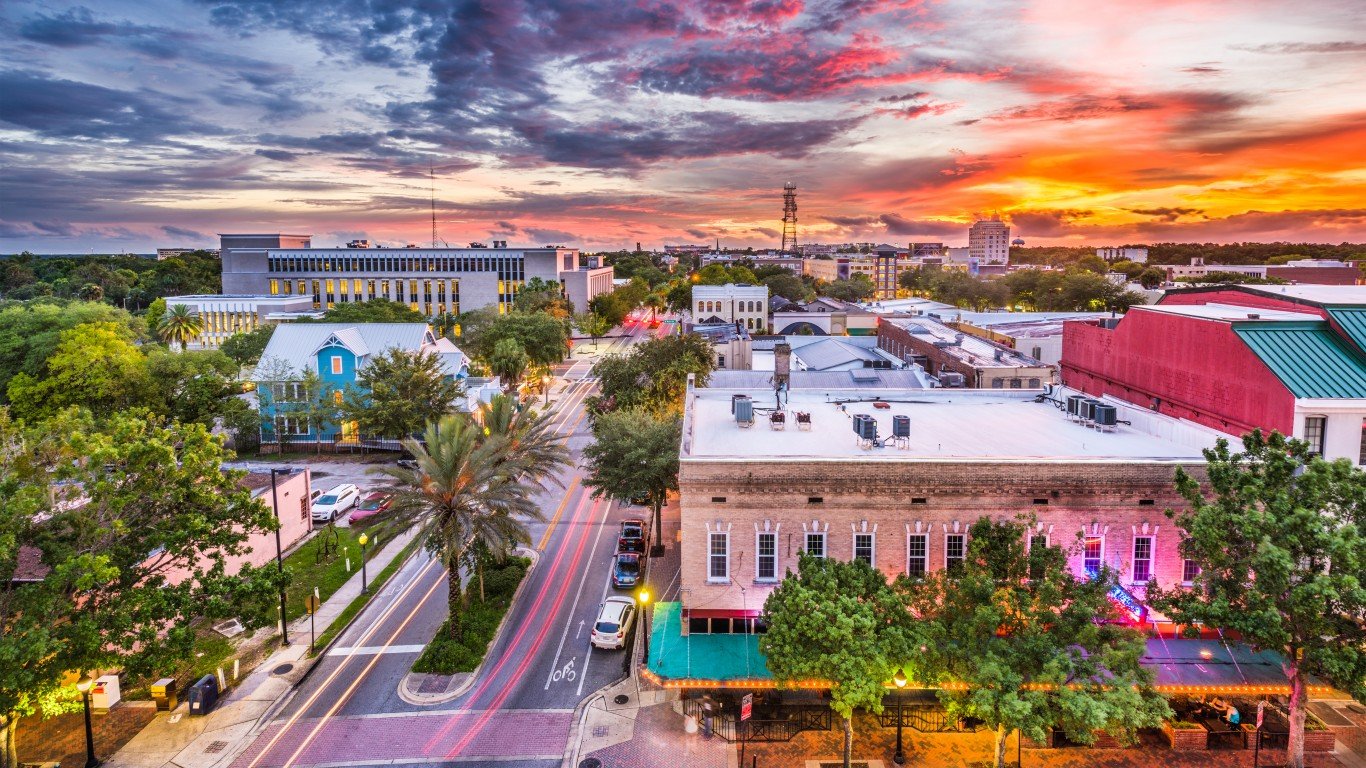
Florida: Gainesville
> Adults with a bachelor’s degree: 38.9% (state: 30.7%)
> Median household income: $47,762 (state: $59,227)
> Number of college and universities: 9
Gainesville is home to the University of Florida, a large public university, as well as a handful of other colleges and universities. Thousands of students graduate from UF every year, and this likely contributes to Gainesville’s 38.9% bachelor’s degree attainment rate — which is nearly 8 percentage points higher than the state rate.
Though higher educational levels tend to correlate with higher incomes, this is not the case in Gainesville. The metro area’s median annual household income of $47,762 is considerably lower than the median income statewide of $59,227.
[in-text-ad-2]
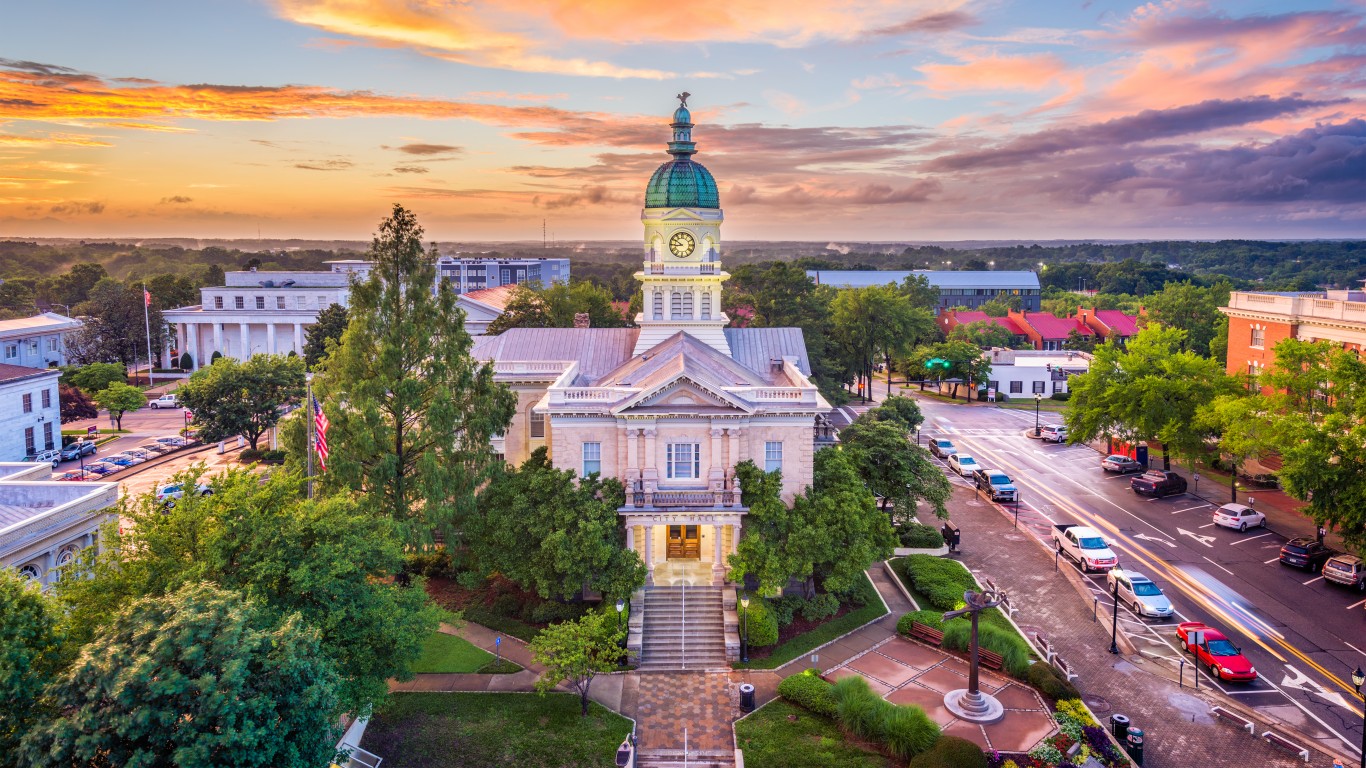
Georgia: Athens-Clarke County
> Adults with a bachelor’s degree: 42.4% (state: 32.5%)
> Median household income: $50,962 (state: $61,980)
> Number of college and universities: 3
Many of the metro areas on this list are home to major research institutions, and Athens, home to the University of Georgia, is one of them. In Athens, 42.4% of adults have at least a bachelor’s degree compared to just 32.5% of adults across the state as a whole.
As is often the case in the metro areas on this list, Athens residents appear to have access to a relatively healthy job market. Just 6.1% of area workers are unemployed, versus the state unemployment rate of 7.6% and the national rate of 10.2%.

Hawaii: Urban Honolulu
> Adults with a bachelor’s degree: 35.8% (state: 33.6%)
> Median household income: $87,470 (state: $83,102)
> Number of college and universities: 21
Of the two metro areas in Hawaii — Urban Honolulu and Kahului-Wailuku-Lahaina — Urban Honolulu is home to the largest share of college-educated adults. The 35.8% share of adults with bachelor’s degrees in the metro area is higher than the 33.6% share statewide. In Kahului-Wailuku-Lahaina, the bachelor’s degree attainment rate is just 27.7%.
[in-text-ad]
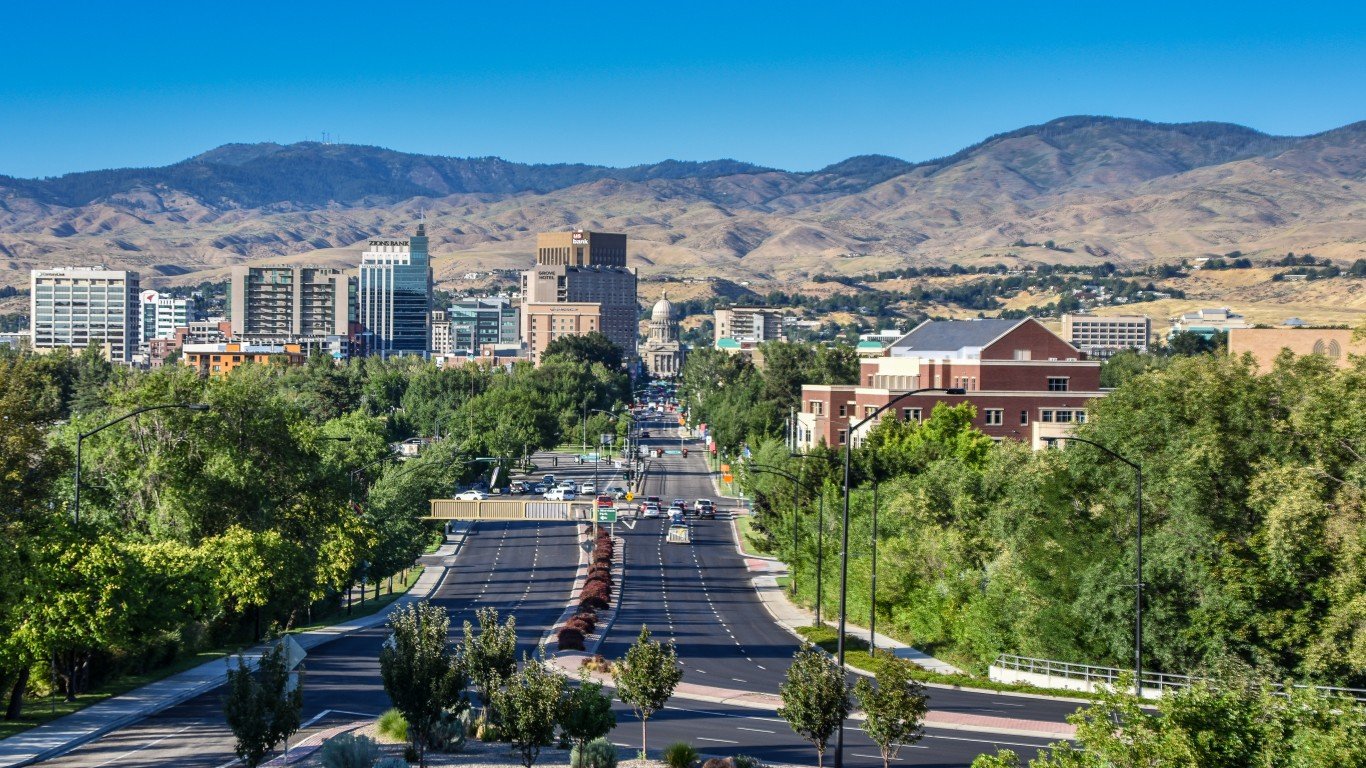
Idaho: Boise City
> Adults with a bachelor’s degree: 33.3% (state: 28.7%)
> Median household income: $66,466 (state: $60,999)
> Number of college and universities: 18
Of the six metro areas in Idaho, Boise City is the only one where as many as a third of adults have at least a bachelor’s degree. Incomes tend to rise with educational attainment, and Boise is also the only metro area in Idaho where the majority of households earn more than $65,000 a year — a higher median income than statewide median but still slightly lower than the national median.
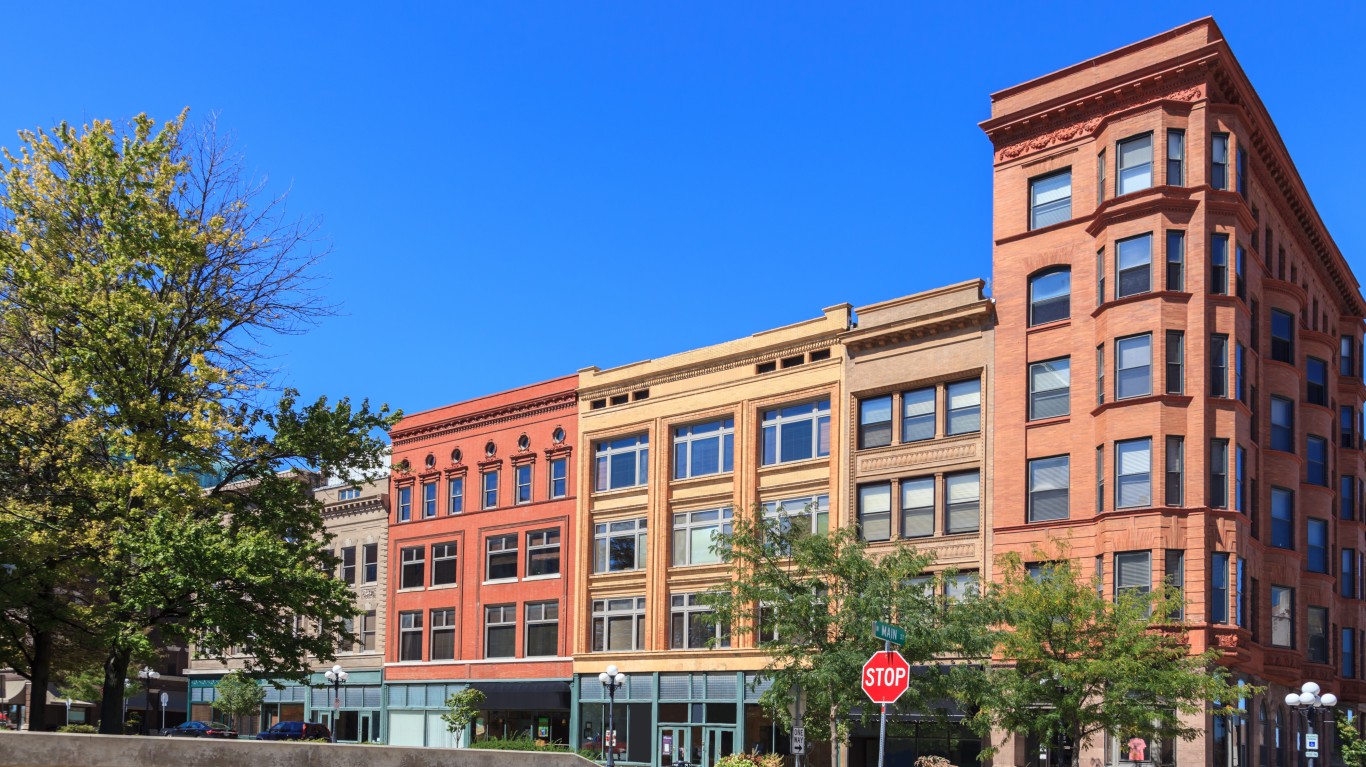
Illinois: Bloomington
> Adults with a bachelor’s degree: 45.8% (state: 35.8%)
> Median household income: $68,784 (state: $69,187)
> Number of college and universities: 5
Bloomington is not only the most highly educated metro area in Illinois, but also one of the best educated in the country. Among Bloomington residents 25 and older, 45.8% have at least a bachelor’s degree — the 19th highest share of any metro area in the country and well above the 35.8% state bachelor’s degree attainment rate.
Incomes tend to rise with educational attainment levels. In Bloomington, however, the typical household earns $68,784, in line with the median income across the state of $69,187.
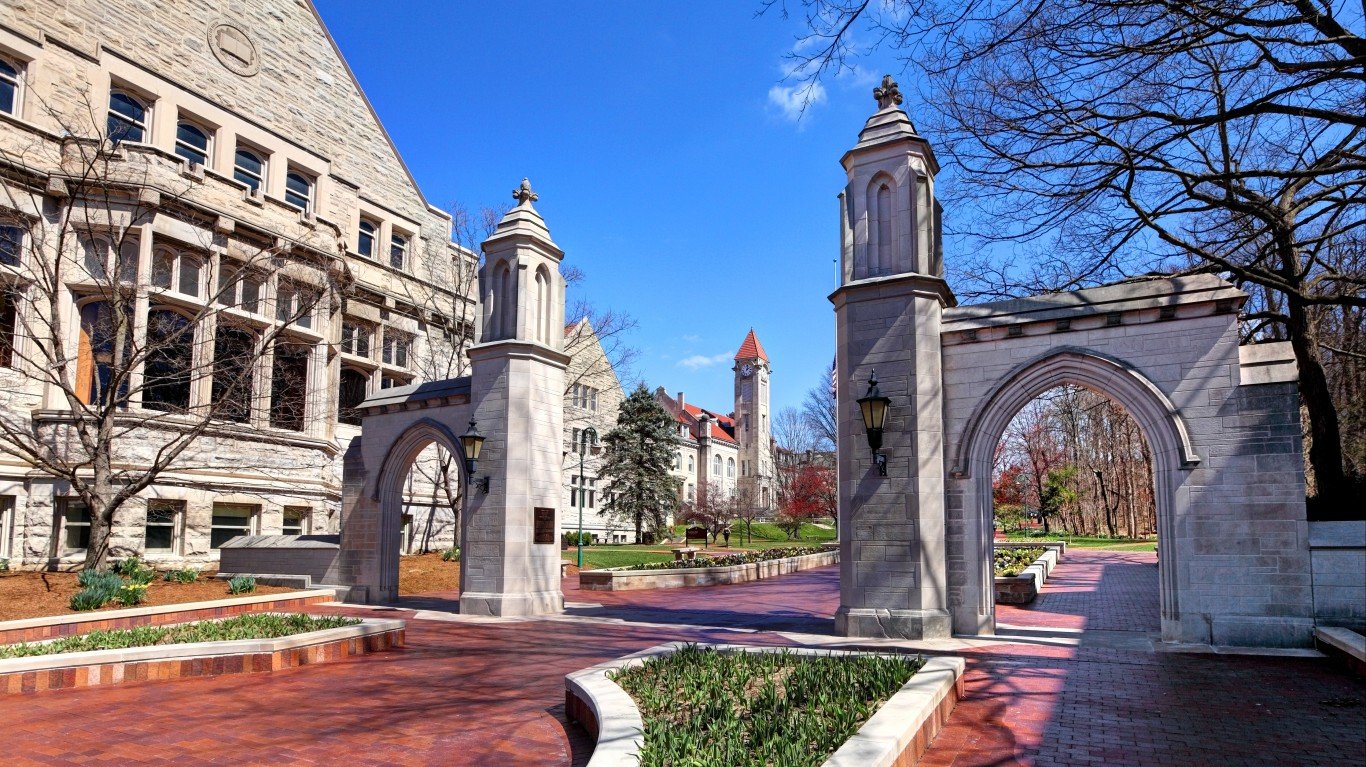
Indiana: Bloomington
> Adults with a bachelor’s degree: 41% (state: 26.9%)
> Median household income: $52,526 (state: $57,603)
> Number of college and universities: 2
Major research universities typically have large graduate student populations and employ highly educated instructors, and partially as a result, college towns often have relatively well-educated populations. Home to Indiana University, Bloomington is no exception. Of all metro area adults, 41.0% have a bachelor’s degree or higher, by far the largest share of the 12 metro areas in the state and well above the 26.9% share of adults across Indiana as a whole.
[in-text-ad-2]
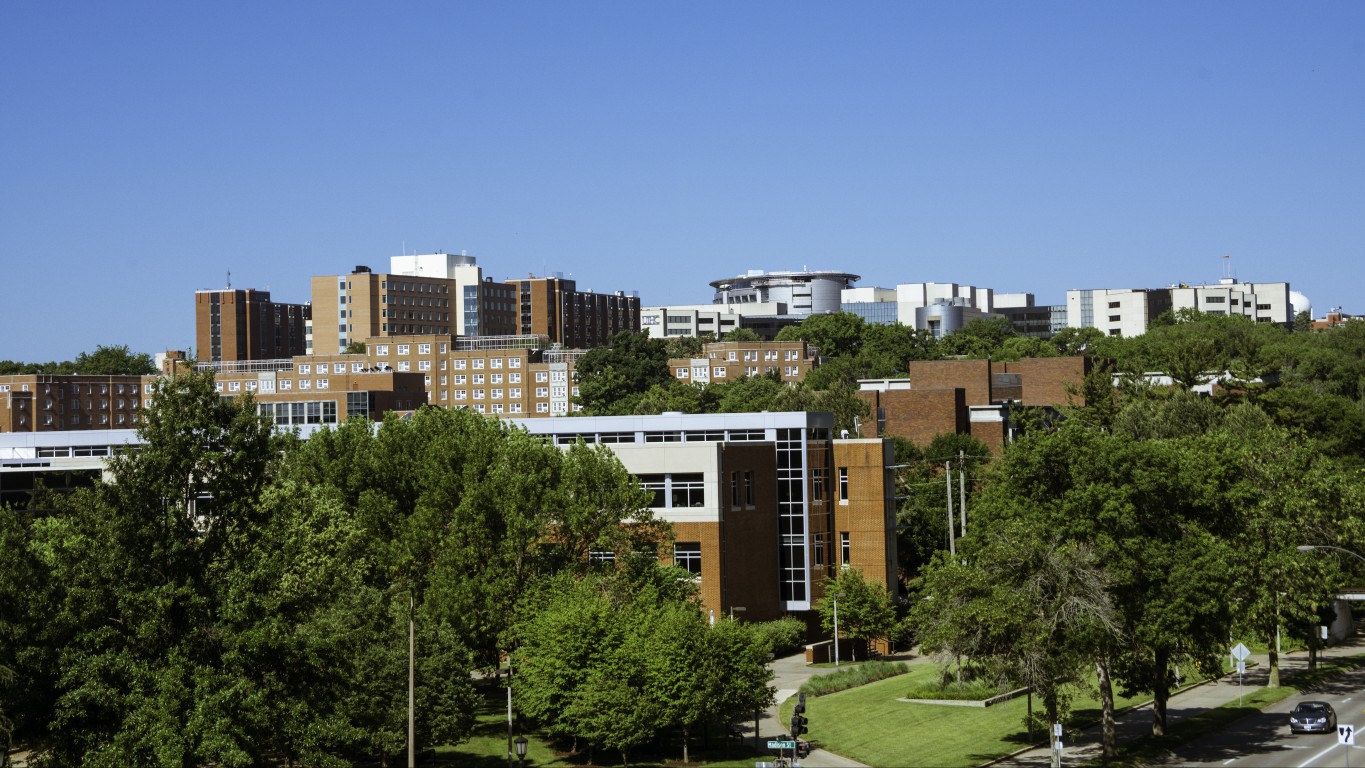
Iowa: Iowa City
> Adults with a bachelor’s degree: 48.8% (state: 29.3%)
> Median household income: $63,761 (state: $61,691)
> Number of college and universities: 4
Nearly half of all Iowa City adults 25 and older, 48.8%, hold at least a bachelor’s degree. This is well above the 29.3% bachelor’s degree attainment rate in Iowa. Higher educational attainment is typically correlated with higher incomes and lower unemployment, and the same is true when comparing Iowa City to the state, though the difference is small.
The Iowa City median household income is just over $2,000 higher than the state median income, and the city’s unemployment rate of 6.0% is slightly lower than the state’s 6.6% unemployment rate.
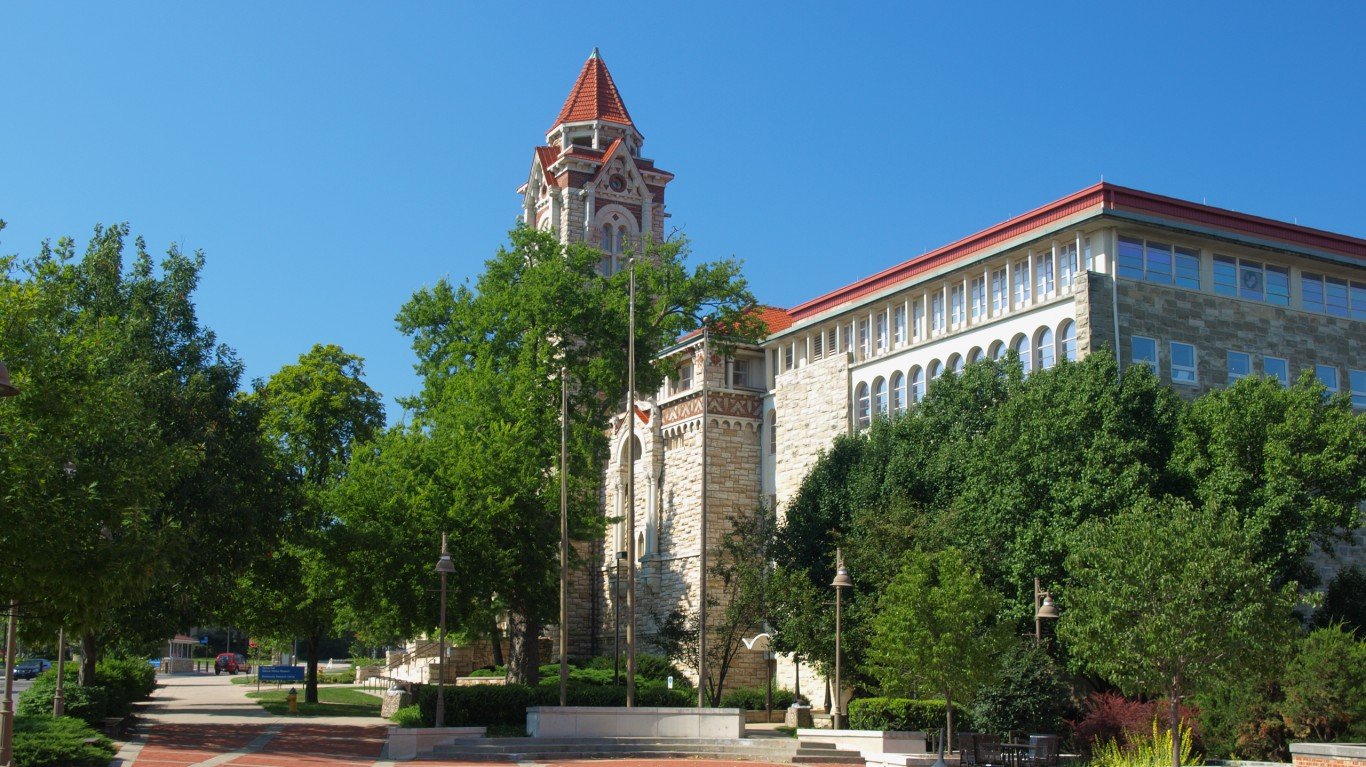
Kansas: Lawrence
> Adults with a bachelor’s degree: 47.1% (state: 34.0%)
> Median household income: $64,233 (state: $62,087)
> Number of college and universities: 5
Many of the best educated metro areas in the United States are college towns, and Lawrence, Kansas, is one of them. Home to the University of Kansas, Lawrence’s bachelor degree attainment rate of 47.1% is the 16th highest of the nation’s 384 metropolitan areas.
Adults in Lawrence are also more likely to have completed high school than adults in the other three metro areas in the state. The high school diploma attainment rate in the area is 96.6%, well above the 91.0% rate across the state as a whole. Nationwide, 88.6% of adults have at least a high school diploma.
[in-text-ad]
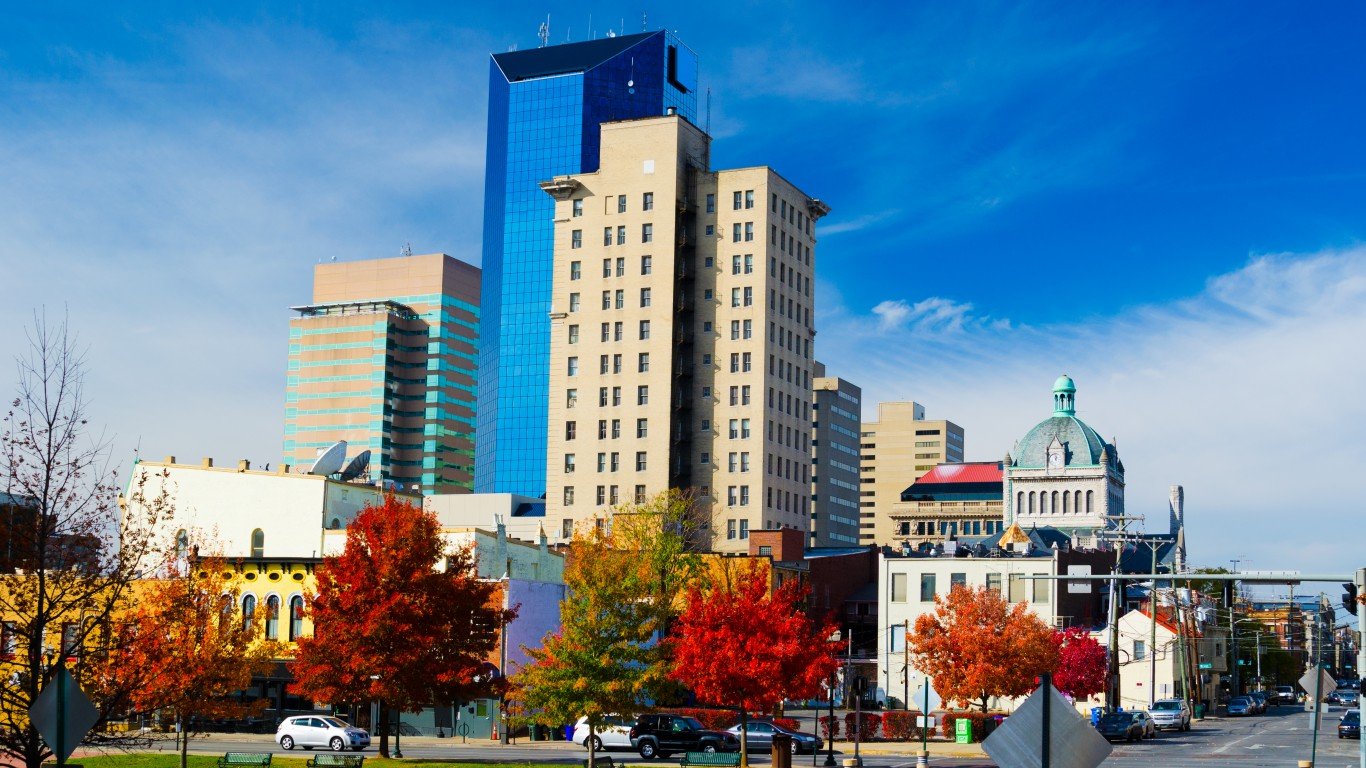
Kentucky: Lexington-Fayette
> Adults with a bachelor’s degree: 38.3% (state: 25.1%)
> Median household income: $60,492 (state: $52,295)
> Number of college and universities: 17
Kentucky’s bachelor’s degree attainment rate of 25.1% is among the lowest of any state. Not all parts of the state, however, have similarly low educational attainment. In the Lexington-Fayette metro area, 38.3% of adults have a four-year college degree, by far the highest of any metro area in the state. Nationwide, 33.1% share of adults have a bachelor’s degree.
Comparing the difference in college attainment rates between states and their most educated metro areas, the 13.2 percentage point difference between Kentucky’s college attainment rate and Lexington-Fayette’s is one of the largest.

Louisiana: New Orleans-Metairie
> Adults with a bachelor’s degree: 32.3% (state: 25.0%)
> Median household income: $55,710 (state: $51,073)
> Number of college and universities: 32
New Orleans is the only Louisiana metro area in which more than 30% of residents 25 and older have a bachelor’s degree. Partly contributing to the higher educational attainment rate in the metro area are the numerous educational institutions in the city. There are 32 colleges and universities in New Orleans and the surrounding area.
Incomes tend to rise with educational attainment, and the relatively large college-educated population in New Orleans likely partially explains the relatively higher incomes in the area when compared to the state as a whole.
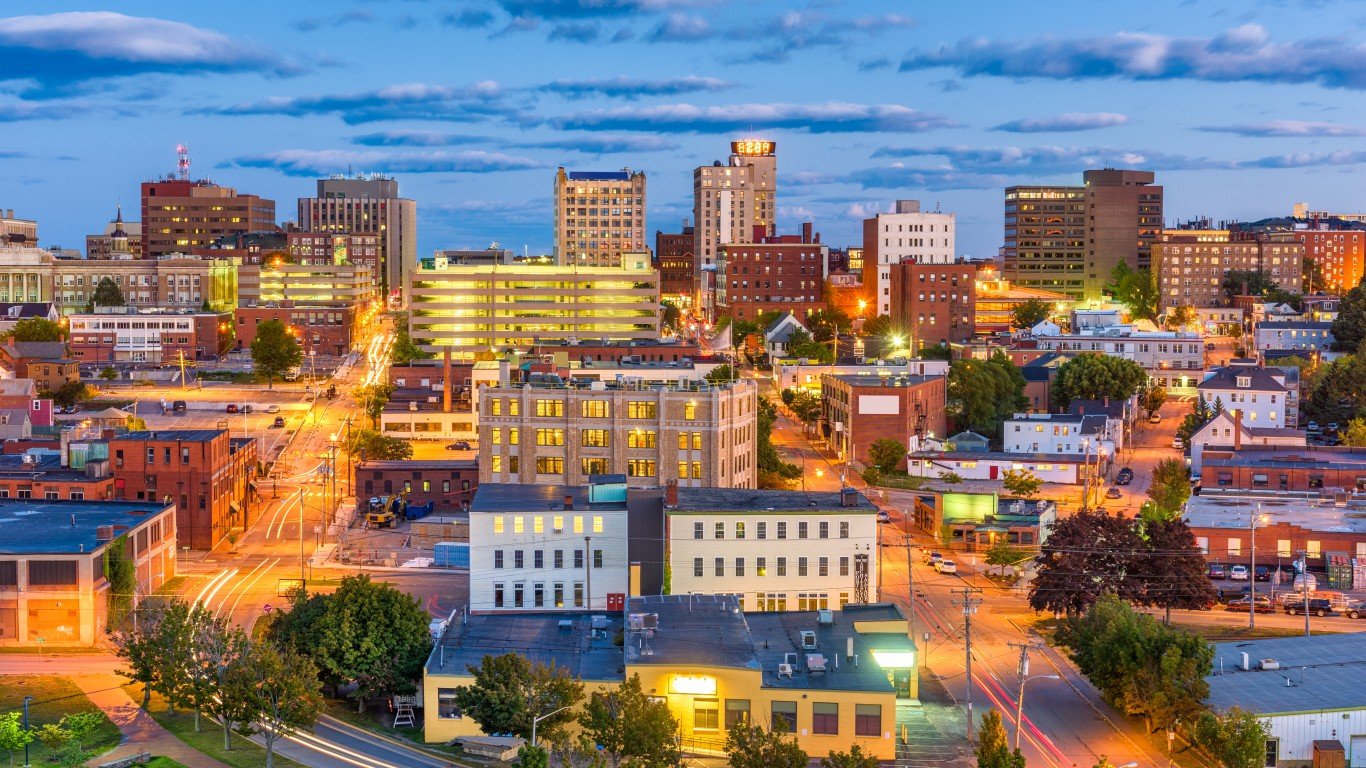
Maine: Portland-South Portland
> Adults with a bachelor’s degree: 42.3% (state: 33.2%)
> Median household income: $71,913 (state: $58,924)
> Number of college and universities: 16
Of the three metro areas in Maine, Portland is by far the best educated. Of all adults in the metro area, 42.3% have a bachelor’s degree or higher. By comparison, 29.4% of adults in the Bangor metro area have a college degree, and in Lewiston-Auburn just 25.1% of adults do. Across Maine, 33.2% of adults have a bachelor’s degree or higher, in line with the 33.1% national share.
[in-text-ad-2]

Maryland: Baltimore-Columbia-Towson
> Adults with a bachelor’s degree: 41.9% (state: 40.9%)
> Median household income: $83,160 (state: $86,738)
> Number of college and universities: 51
Maryland is one of the best educated states in the country, with a bachelor’s degree attainment rate of 40.9% — well above the 33.1% national rate. Of the five metro areas in the state, Baltimore-Columbia-Towson is by far the best educated. Some 41.9% of metro area adults have at least a bachelor’s degree. The area is home to dozens of higher education institutions, including Johns Hopkins University and Loyola University – Maryland.

Massachusetts: Boston-Cambridge-Newton, MA-NH
> Adults with a bachelor’s degree: 49.3% (state: 45.0%)
> Median household income: $94,430 (state: $85,843)
> Number of college and universities: 122
Boston is the most educated metro area in the most educated state. Across Massachusetts, 45.0% of adults have at least a bachelor’s degree, well above the 33.1% share of adults nationwide. In the Boston metro area, educational attainment is even higher, with 49.3% of adults holding at least a four-year college degree. As is often the case in the metro areas on this list, Boston has a high concentration of colleges and universities. The greater Boston metro area encompasses over 100 schools, including Boston College, Boston University, Harvard University, MIT, and Northeastern University.
[in-text-ad]

Michigan: Ann Arbor
> Adults with a bachelor’s degree: 55.9% (state: 30.0%)
> Median household income: $76,576 (state: $59,584)
> Number of college and universities: 5
Home to the University of Michigan, Ann Arbor is a quintessential American college town. As is the case in many other metro areas with major research universities, Ann Arbor residents are far more likely than most Americans to have a bachelor’s degree. The metro area is one of only seven nationwide in which over half of all adults have a bachelor’s degree or higher.
Better-educated adults have access to a broader range of high-paying jobs, and as a result, better-educated areas typically have higher median household incomes. In Ann Arbor, the typical household has an income of $76,576 a year, well above the median of $59,584 across Michigan as a whole.

Minnesota: Minneapolis-St. Paul-Bloomington, MN-WI
> Adults with a bachelor’s degree: 43.2% (state: 37.3%)
> Median household income: $83,698 (state: $74,593)
> Number of college and universities: 66
The bachelor’s degree attainment rate in Twin Cities is 43.2%, the highest of any metro area in Minnesota. Adults with a four-year college degree are more likely to have secure, high-paying jobs than those with lower educational attainment, and as a result they are less likely to face serious financial hardship. The Twin Cities’ poverty rate is just 8.2%, below the 9.0% state poverty rate and lower than the vast majority of the nearly 400 metro areas nationwide.
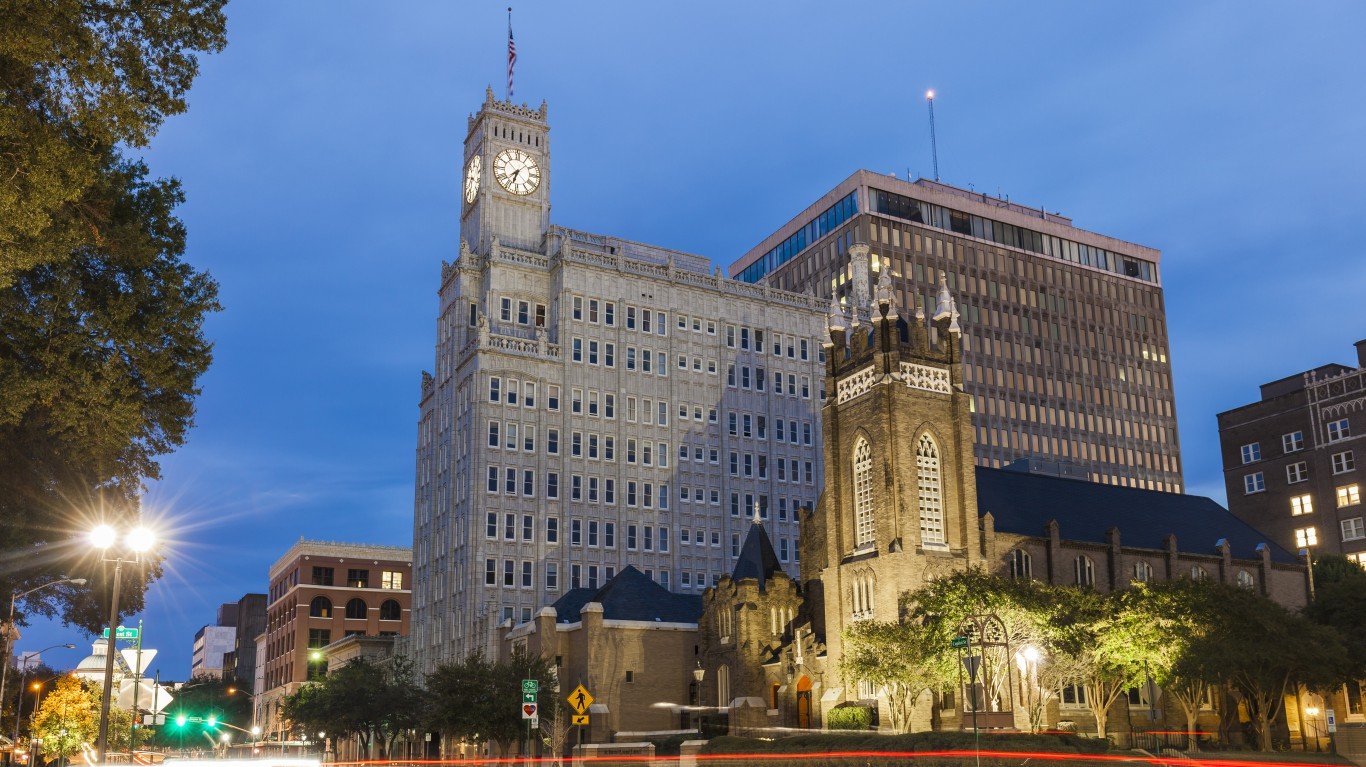
Mississippi: Jackson
> Adults with a bachelor’s degree: 31.0% (state: 22.3%)
> Median household income: $52,426 (state: $45,792)
> Number of college and universities: 21
Mississippi has nearly the lowest educational attainment rate of any state. Just 22.3% of adults in the state have a bachelor’s degree or higher, compared to the national bachelor’s degree attainment rate of 33.1%. In Jackson, the state capital and best educated metro area in the state, 31.0% of adults have a bachelor’s degree, below the national rate.
As is often the case in other states, Mississippi’s best educated city has a healthier job market than the state as a whole. In Jackson, 10.1% of the workforce is unemployed, compared to 10.8% of the workforce across Mississippi. Both the city and state unemployment rates are considerably higher than they were a year ago because of the pandemic.
[in-text-ad-2]
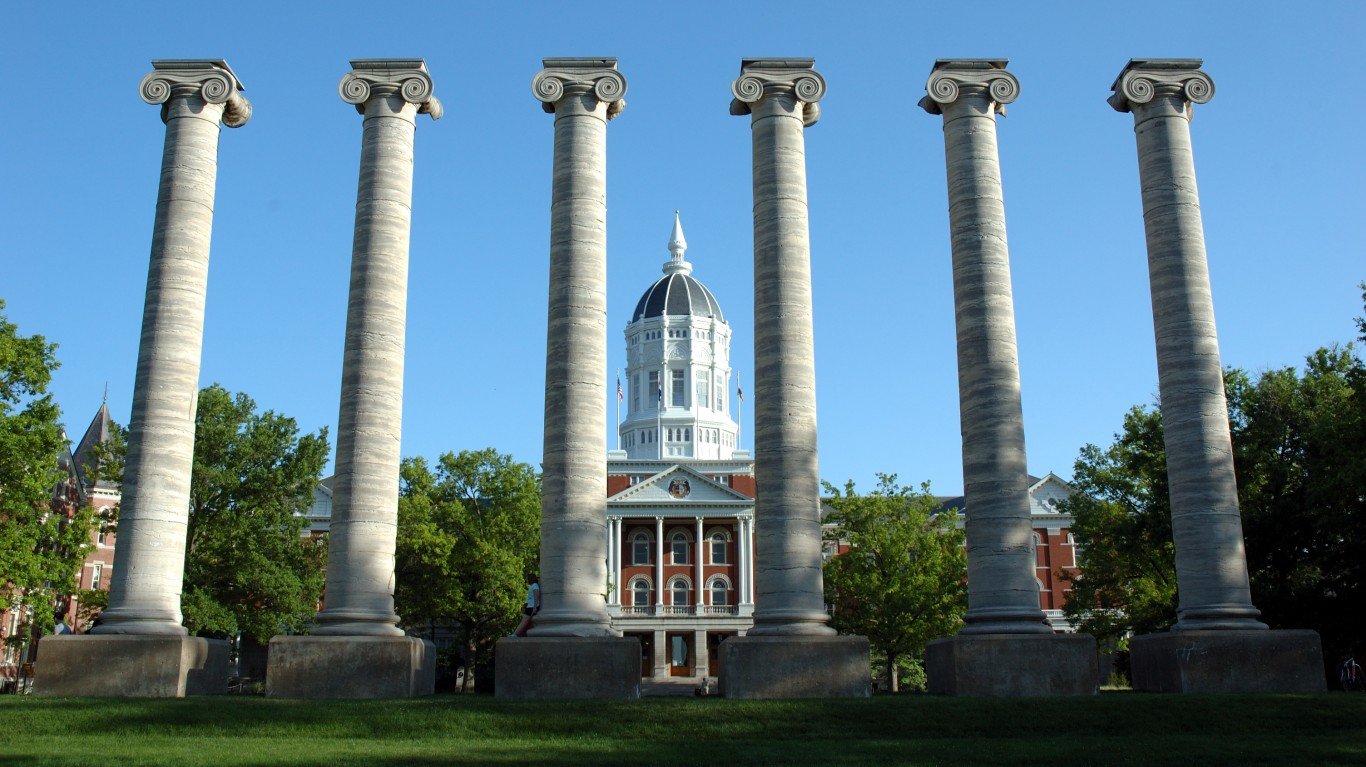
Missouri: Columbia
> Adults with a bachelor’s degree: 44.0% (state: 30.2%)
> Median household income: $57,359 (state: $57,409))
> Number of college and universities: 9
Columbia is home to the University of Missouri, the state’s flagship university and largest college by enrollment, as well as eight other higher learning institutions. This is likely contributing to the metro area’s high bachelor’s degree attainment rate of 44.0% — well beyond the state rate of 30.2%.
Unemployment is less likely for workers with higher educational attainment. This partially explains the area’s unemployment rate of just 4.7%, well below the 6.9% state rate and 10.2% national rate and one of the lowest of any metro area in the country.
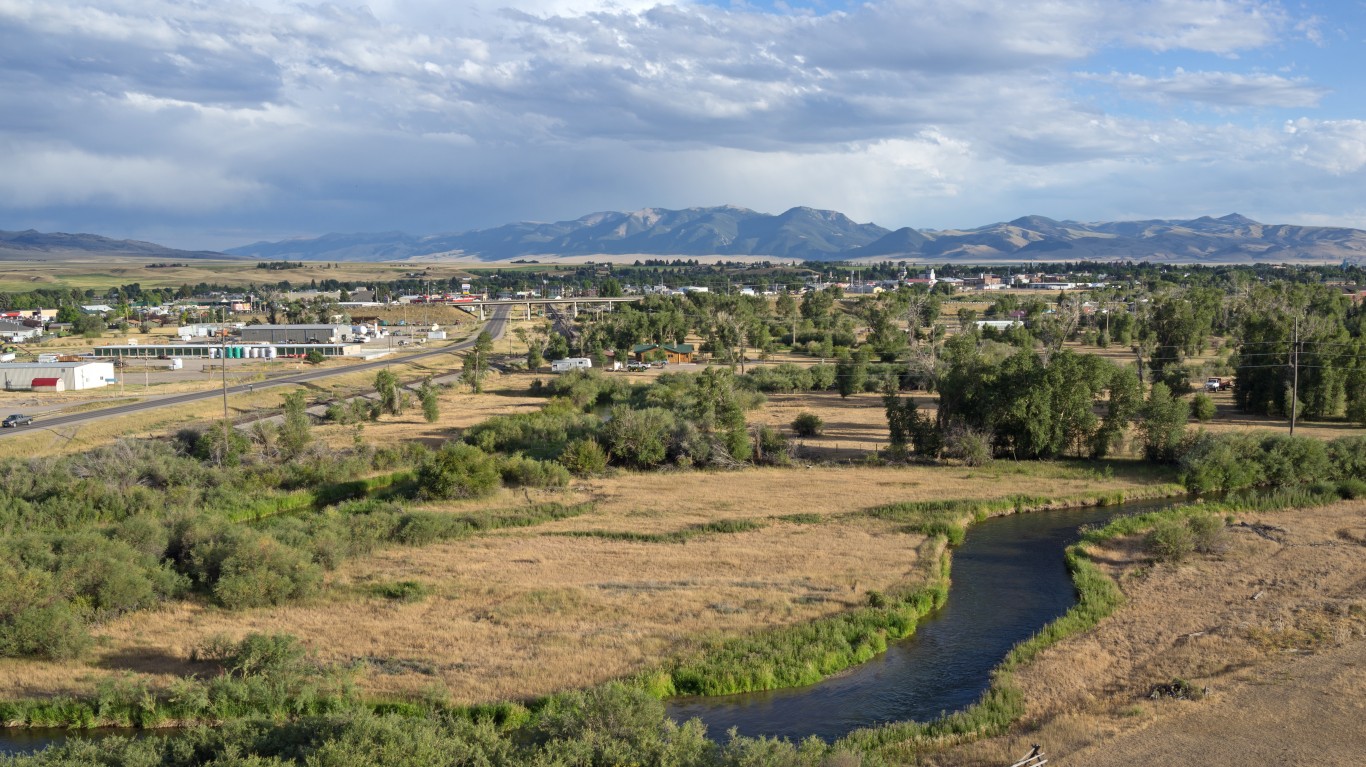
Montana: Missoula
> Adults with a bachelor’s degree: 44.4% (state: 33.6%)
> Median household income: $57,347 (state: $57,153)
> Number of college and universities: 1
Some 44.4% of adults in Missoula have a bachelor’s degree, by far the largest share of the three metro areas in Montana. One factor contributing to the area’s high college attainment rate is the presence of the University of Montana, which enrolls some 11,000 students.
In many metro areas on this list, unemployment is relatively low and incomes are relatively high. In Missoula, however, the July unemployment rate of 6.5% is in line with the statewide rate of 6.4%. Similarly, the median household income in the metro area of $57,347 is only slightly above the $57,153 statewide median.
[in-text-ad]
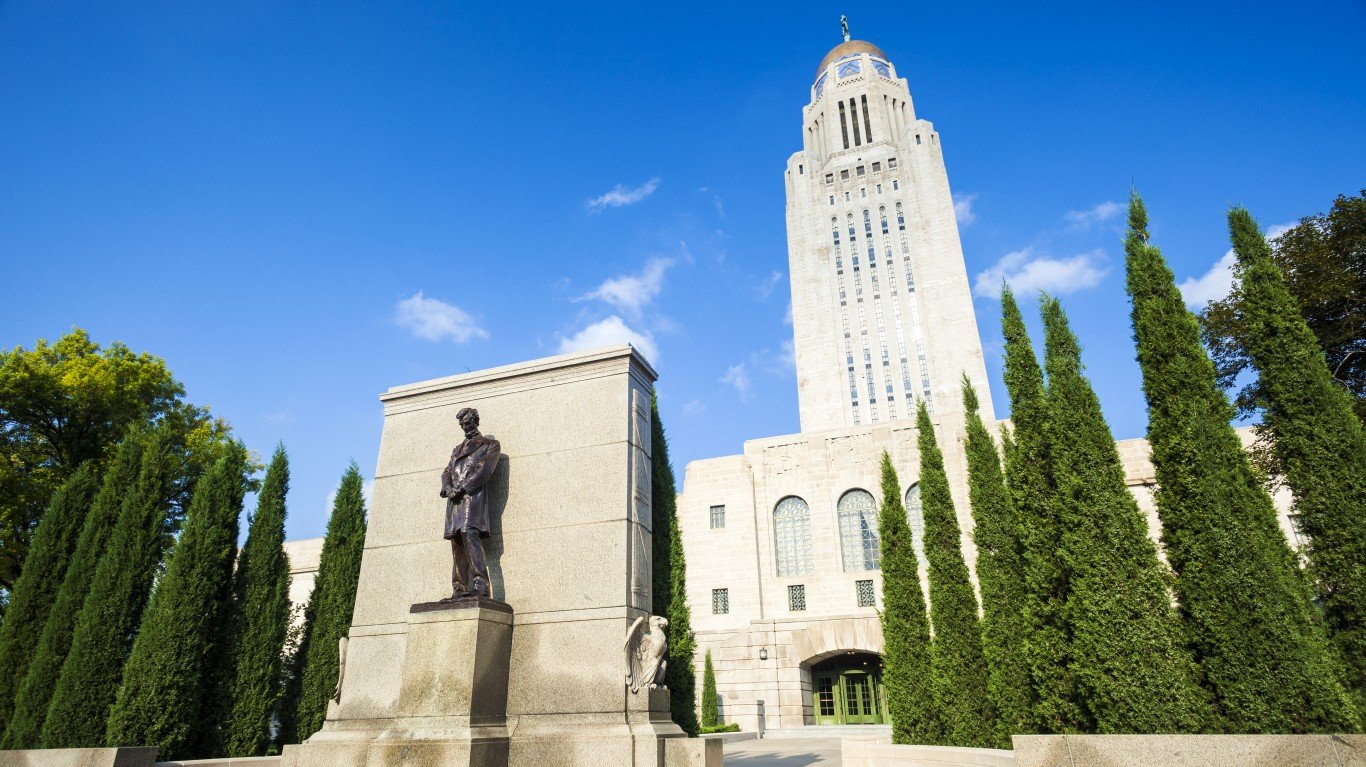
Nebraska: Lincoln
> Adults with a bachelor’s degree: 39.7% (state: 33.2%)
> Median household income: $61,539 (state: $63,229)
> Number of college and universities: 15
In Lincoln, 39.7% of adults have a bachelor’s degree or higher, well above the 33.2% of adults across Nebraska as a whole. Many of the metro areas on this list are college towns, and Lincoln — home to the University of Nebraska — is one of them. Lincoln is also Nebraska’s capital, and a college degree is often required for many government jobs.
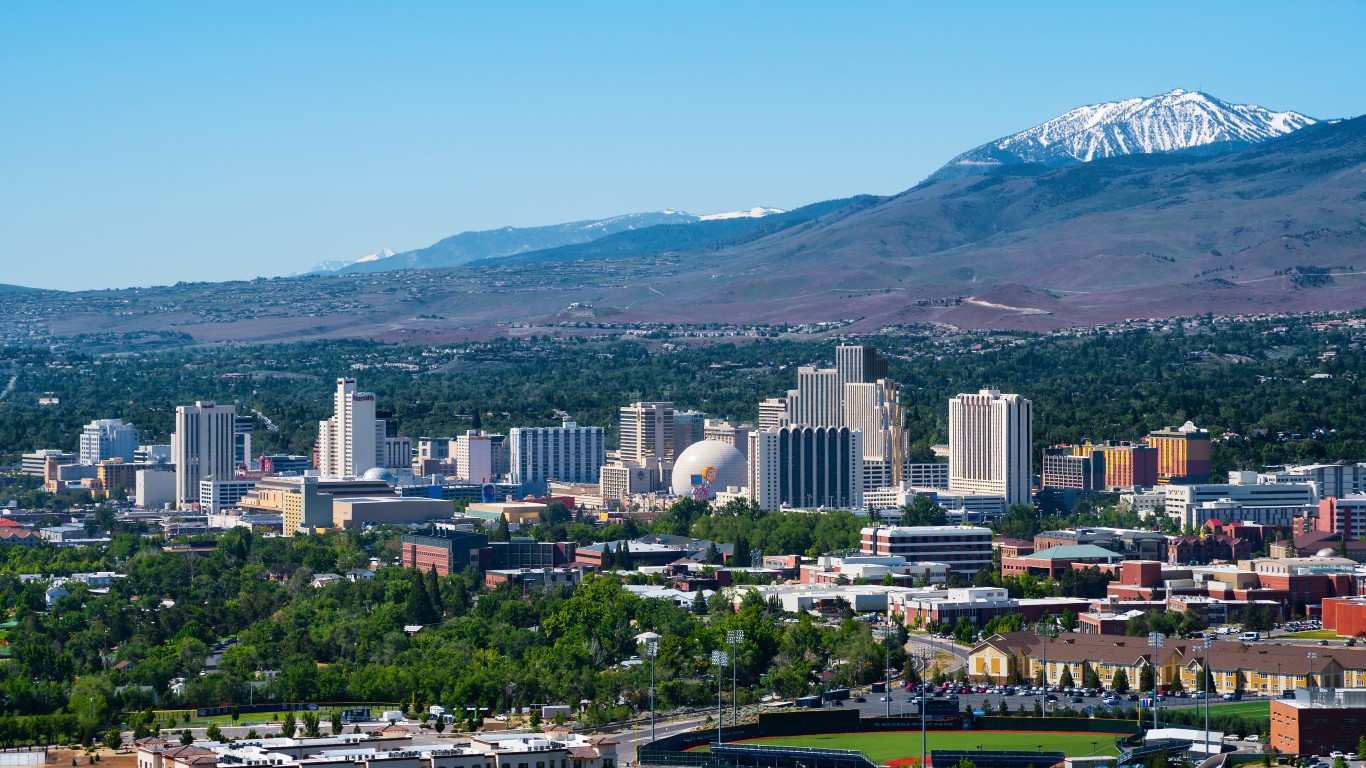
Nevada: Reno
> Adults with a bachelor’s degree: 31.6% (state: 25.7%)
> Median household income: $72,132 (state: $63,276)
> Number of college and universities: 10
Nevada has one of the lowest educational attainment rates in America, as only about a quarter of adults 25 and over have a bachelor’s degree. Reno is the only one of the three Nevada metro areas to have a bachelor’s degree attainment rate higher than the state rate.
Places with higher college education attainment tend to generally have higher incomes. The typical household in Reno has an annual income of $72,132, which is the highest in the state and slightly above the national median of $65,712.
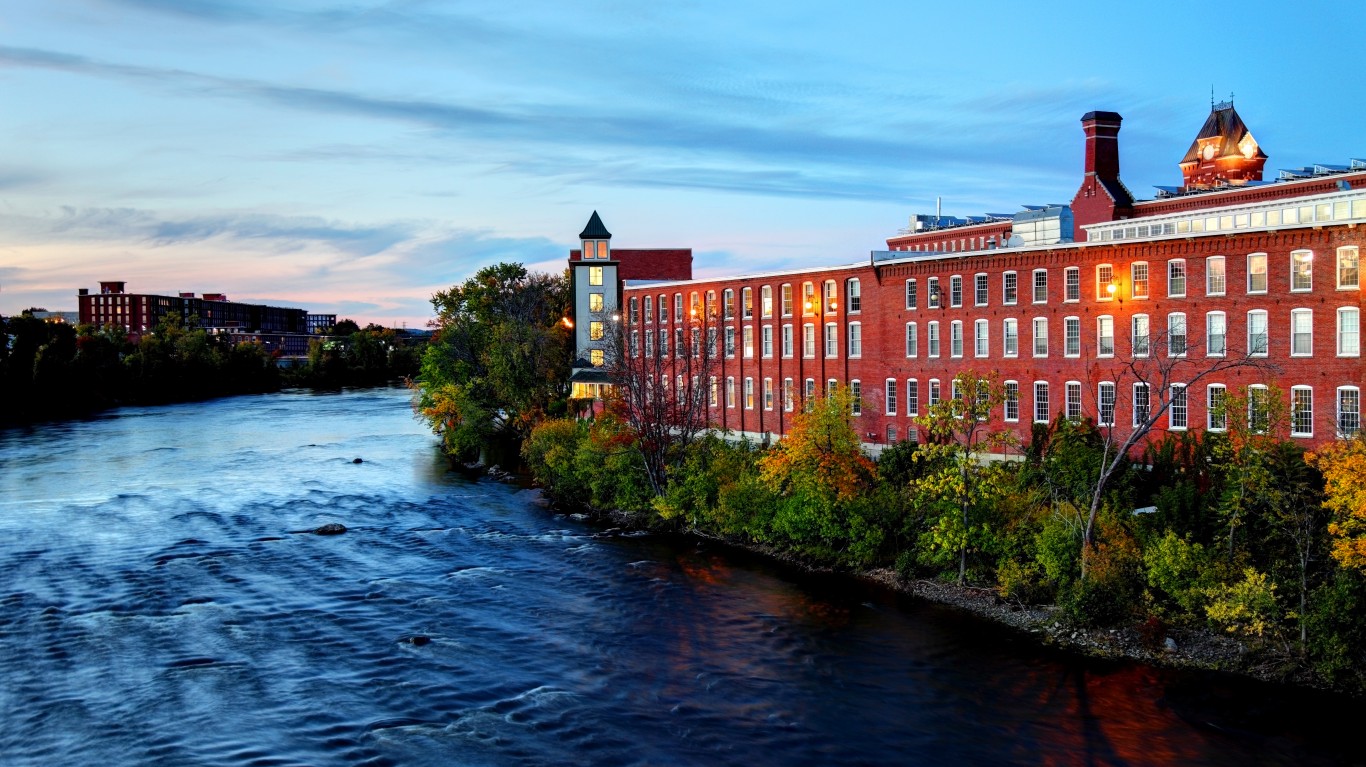
New Hampshire: Manchester-Nashua
> Adults with a bachelor’s degree: 37.8% (state: 37.6%)
> Median household income: $83,626 (state: $77,933)
> Number of college and universities: 15
New Hampshire has one of the highest educational attainment rates in the country, with 37.6% of adults holding at least a bachelor’s degree. The Manchester-Nashua metro area, which is the only metro area in the state, has a slightly higher bachelor’s attainment rate than the state, at 37.8%.
Educational attainment is closely tied to income, and Manchester is one of the more affluent metro areas in the country, with a median annual household income of $83,626, which is even higher than the state’s relatively high median income of $77,933 and well above the national median of $65,712.
[in-text-ad-2]

New Jersey: Trenton-Princeton
> Adults with a bachelor’s degree: 44.5% (state: 41.2%)
> Median household income: $79,492 (state: $85,751)
> Number of college and universities: 10
New Jersey is one of just four states in which more than 40% of adults hold at least a bachelor’s degree. The Trenton-Princeton area is home to 10 colleges and universities, including Princeton University.
Though the median household income in the Trenton-Princeton area is over $6,000 lower than the median across New Jersey, area workers are less likely to be unemployed than workers statewide. New Jersey’s 13.8% July 2020 unemployment rate is the fourth highest among states, yet the unemployment rate in the Trenton area is 10.6%.
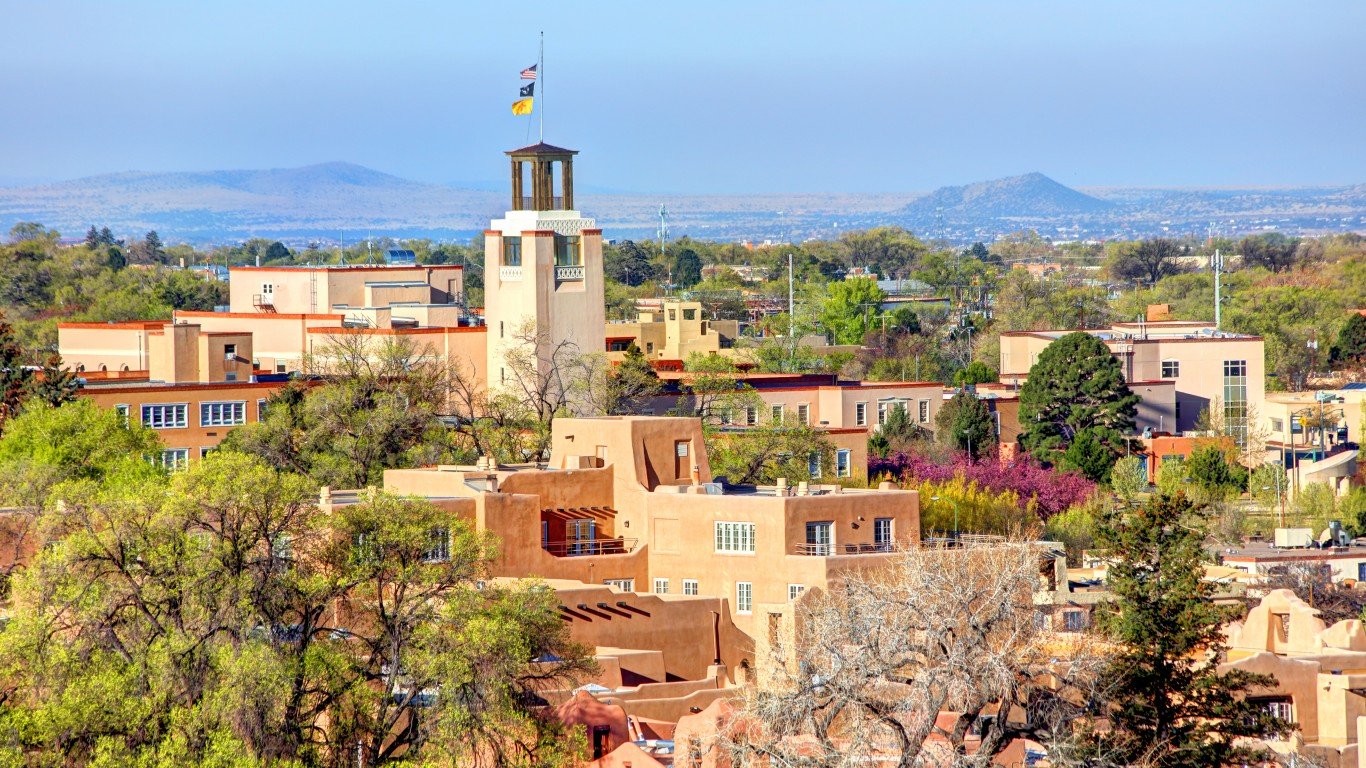
New Mexico: Santa Fe
> Adults with a bachelor’s degree: 40.1% (state: 27.7%)
> Median household income: $61,298 (state: $51,945)
> Number of college and universities: 7
Santa Fe is home to, and within commuting distance of, a number of scientific and technical employers and institutes, including the Los Alamos National Laboratory and the Santa Fe Institute. The strong presence of tech and research employers helps explain the state capital’s high educational attainment rate.
While New Mexico’s educational attainment rate is below that of most states, at 27.7%, Santa Fe stands out as having a more than 40% bachelor’s degree attainment rate.
[in-text-ad]
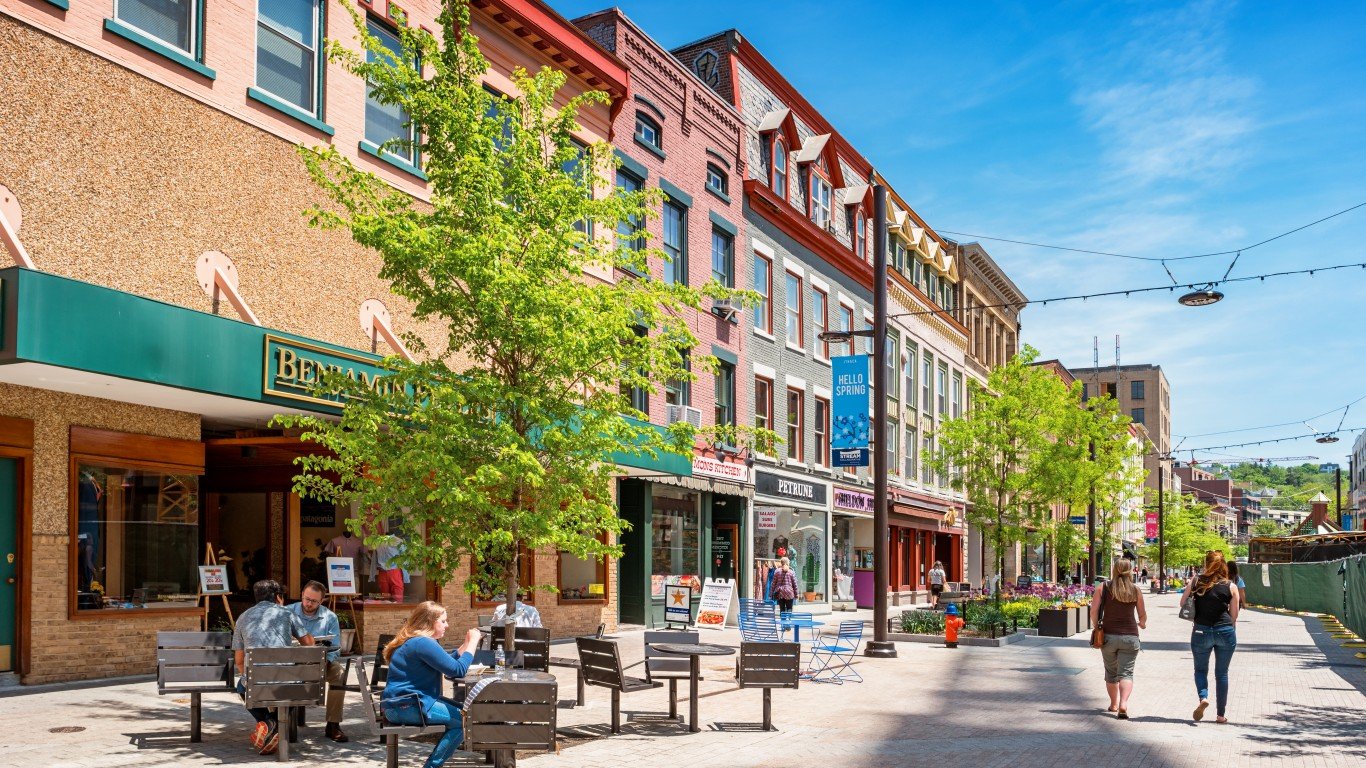
New York: Ithaca
> Adults with a bachelor’s degree: 56.9% (state: 37.8%)
> Median household income: $58,626 (state: $72,108)
> Number of college and universities: 4
Ithaca, New York, is home to Ivy League school Cornell University as well as three other schools. The Ithaca area is by far the most highly educated metro area in New York as well more than half of adults hold at least a bachelor’s degree, the third highest share among U.S. metro areas. The next closest metro area, New York City, has a bachelor’s degree attainment rate of 41.8%.

North Carolina: Raleigh-Cary
> Adults with a bachelor’s degree: 48.0% (state: 32.3%)
> Median household income: $80,096 (state: $57,341)
> Number of college and universities: 20
Though less than a third of North Carolina adults hold at least a bachelor’s degree, nearly half of adults in the Raleigh-Cary area have earned a four-year degree. The metro area comprises much of what is known as the Research Triangle — the area between Duke University, University of North Carolina – Chapel Hill, and North Carolina State University.
With thousands of students graduating from these schools each year, numerous science and technology businesses have set up operations in the area, attracting even more college-educated workers to this part of North Carolina. Jobs in the area tend to pay relatively well as most households in the Raleigh-Cary area earn over $80,000 annually, compared to the state’s median annual household income of $57,341.
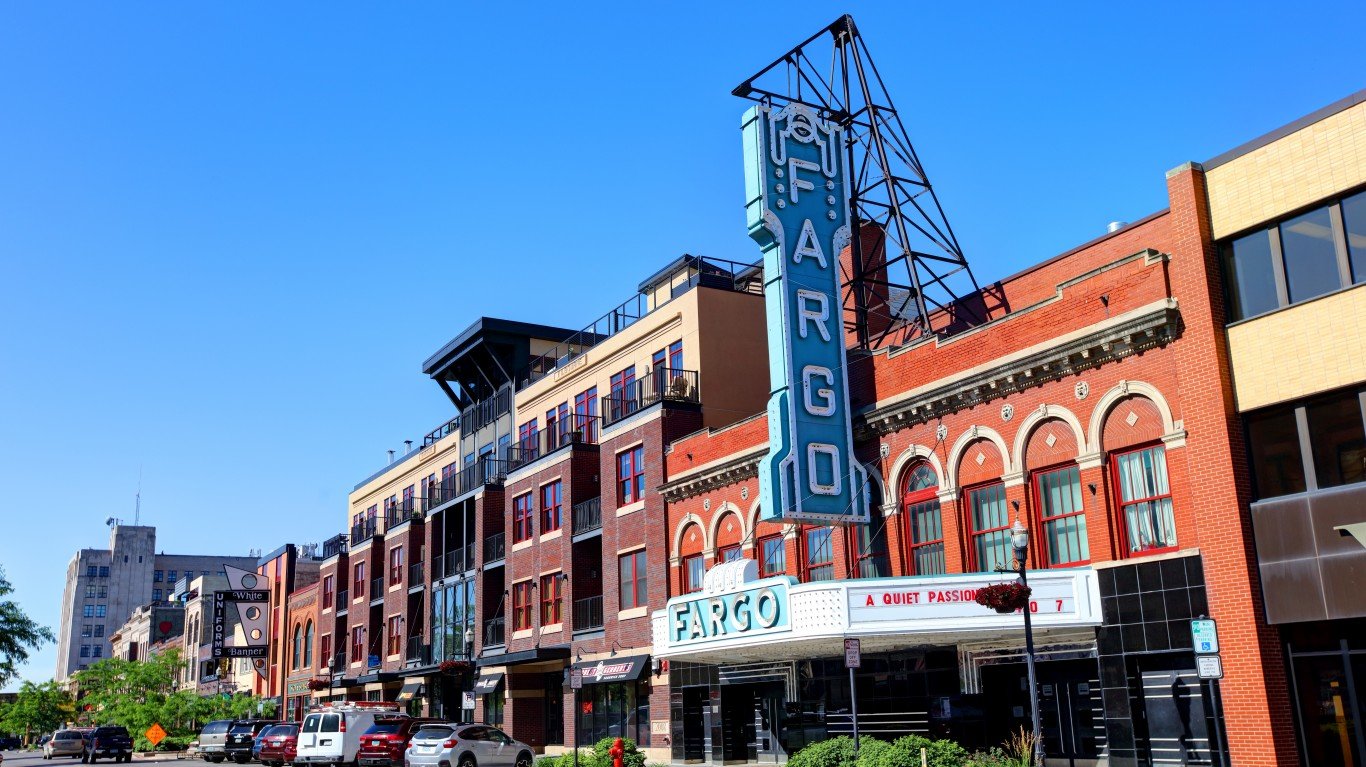
North Dakota: Fargo, ND-MN
> Adults with a bachelor’s degree: 40.4% (state: 30.4%)
> Median household income: $62,820 (state: $64,577)
> Number of college and universities: 9
Of the three major metro areas in North Dakota, Fargo has the highest bachelor’s degree attainment rate, at 38.3%. A relatively large share of the metro area’s workforce is employed in the finance and insurance sector as well as the information sector. Both sectors tend to consist of jobs that require a bachelor’s degree. There are nine postsecondary institutions in the metro area, more than the other two metro areas in the state — Bismarck and Grand Forks — combined.
[in-text-ad-2]
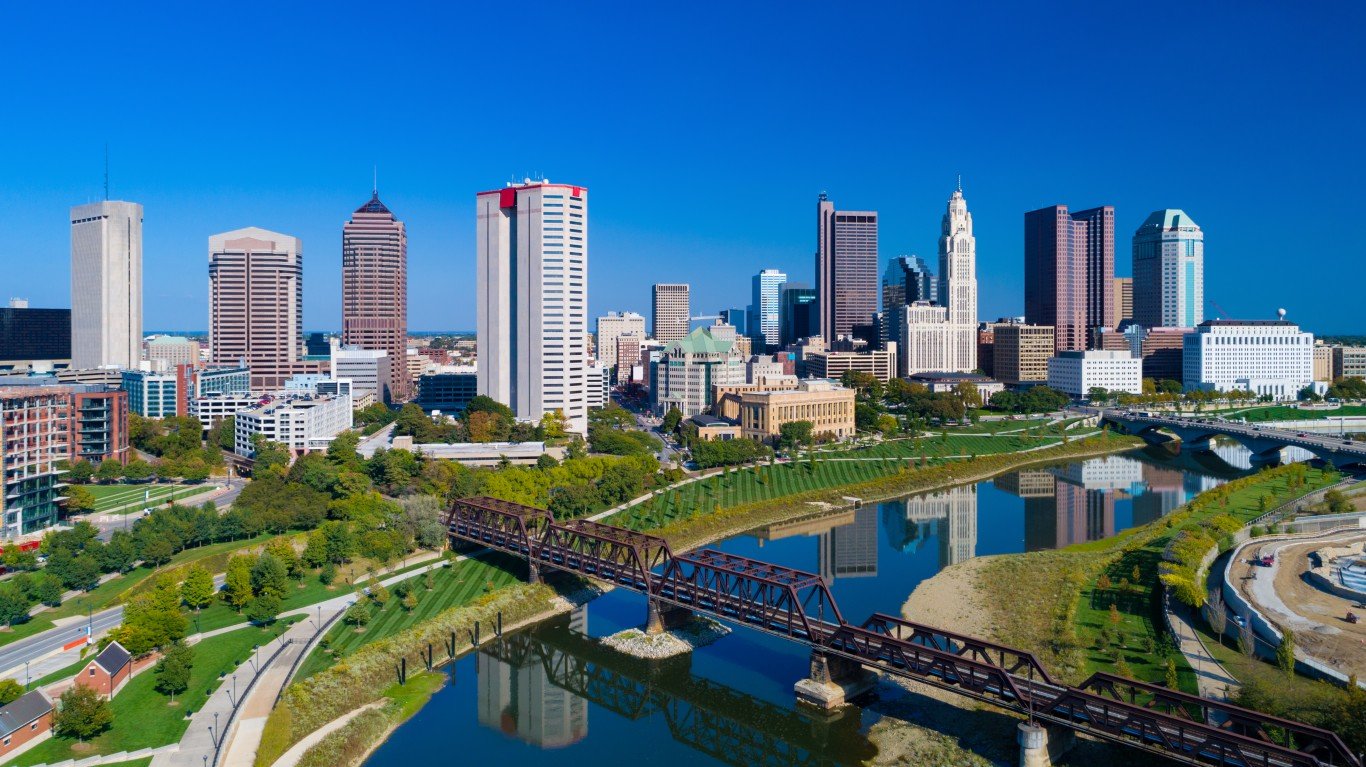
Ohio: Columbus
> Adults with a bachelor’s degree: 37.9% (state: 29.3%)
> Median household income: $67,207 (state: $58,642)
> Number of college and universities: 48
Like the state as a whole, the bachelor’s degree attainment rate in the majority of metro areas in Ohio is below the national rate of 33.1%. Columbus’s bachelor’s degree attainment rate is over 8 percentage points higher than the national rate.
Metropolitan areas with a substantial presence of colleges and universities tend to have higher educational attainment rates. Columbus is home to Ohio State University, one of the largest schools in the country, as well as several other postsecondary education institutions. Columbus is also home to Battelle Memorial Institute, a private, nonprofit research institution.

Oklahoma: Oklahoma City
> Adults with a bachelor’s degree: 31.5% (state: 26.2%)
> Median household income: $60,605 (state: $54,449)
> Number of college and universities: 36
Oklahoma has one of the lowest bachelor’s degree attainment rates in the country. Even the metro area with the highest bachelor’s degree attainment rate in the state, Oklahoma City, has a lower rate than the nation. Still, it is the only metro area in the state with a college attainment rate above 30%, likely in large part due to the presence of higher learning institutions in the city. Oklahoma City is home to several major colleges and universities, including Oklahoma City University.
[in-text-ad]
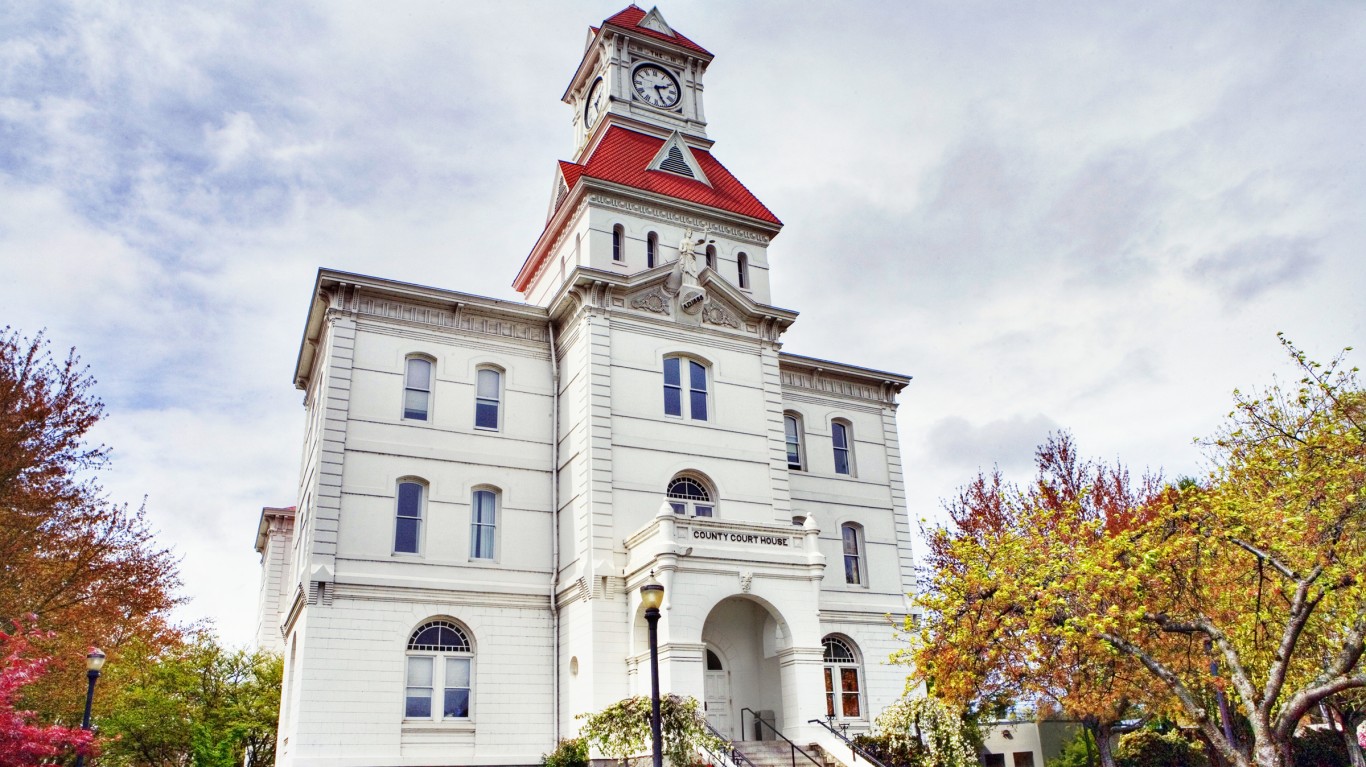
Oregon: Corvallis
> Adults with a bachelor’s degree: 57.9% (state: 34.5%)
> Median household income: $70,835 (state: $67,058)
> Number of college and universities: 2
The presence of colleges and universities in a metropolitan area tends to be tied to higher educational attainment. While there are other metropolitan areas in the state with more postsecondary institutions, such as Portland, Corvallis is a small enough metro area that higher-learning institutions represent a more substantial part of the economy. The metro area is home to the campus of Oregon State University, which is the largest employer in the city. The metro area’s 57.9% share of adults with a bachelor’s degree is the second highest in the country.
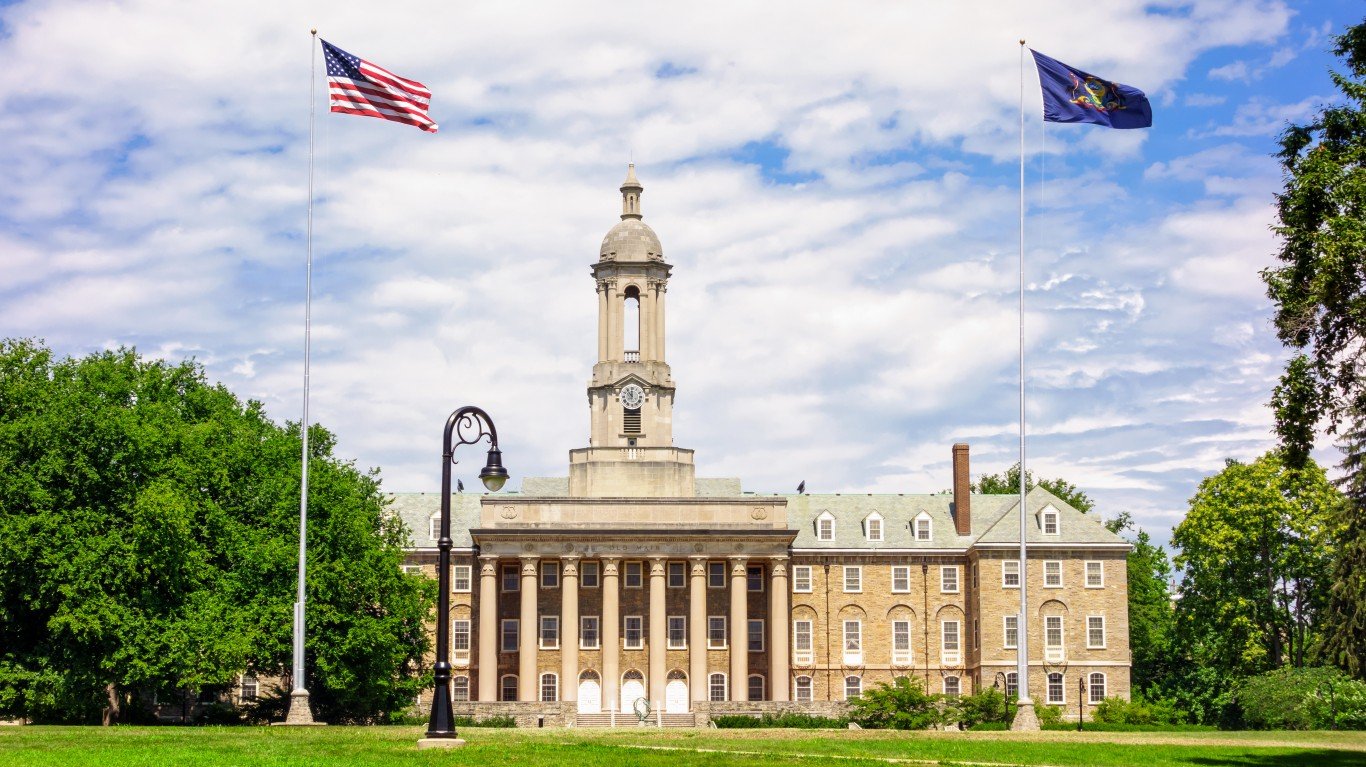
Pennsylvania: State College
> Adults with a bachelor’s degree: 43.8% (state: 32.3%)
> Median household income: $60,706 (state: $63,463)
> Number of college and universities: 4
The State College area, also known as Happy Valley, is home to Penn State University. The metro area’s 43.8% bachelor’s degree attainment rate is by far the highest in the state and well above Pennsylvania’s 32.3% rate. As is often the case in the cities on this list, the best educated metro area in Pennsylvania has a relatively strong job market which has so far endured the COVID-19 impact better than much of the rest of the state. Just 8.8% of workers in State College are unemployed, compared to Pennsylvania’s 13.7% unemployment rate.
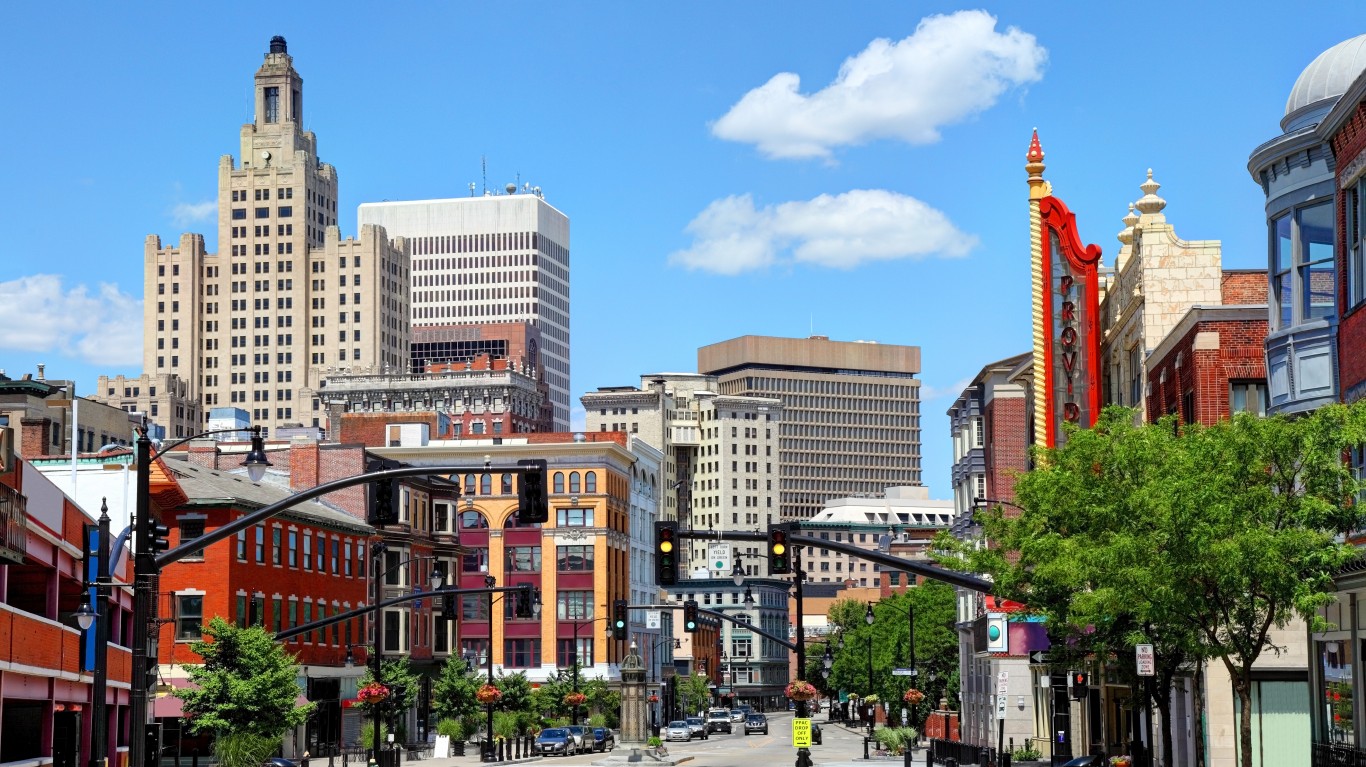
Rhode Island: Providence-Warwick, RI-MA
> Adults with a bachelor’s degree: 33.2% (state: 34.8%)
> Median household income: $70,967 (state: $71,169)
> Number of college and universities: 35
Providence-Warwick ranks as Rhode Island’s most educated city despite having a bachelor’s degree attainment rate of 33.2% — slightly below the U.S. and state rates. This is because Providence is the only major metro area in the state. In fact, the metro area comprises the entire state of Rhode Island as well as Bristol County, Massachusetts. There is certainly no shortage of places for people in the Providence area to get a college education. The metro area is home to over 30 different higher learning institutions, including the Ivy League school Brown University.
[in-text-ad-2]
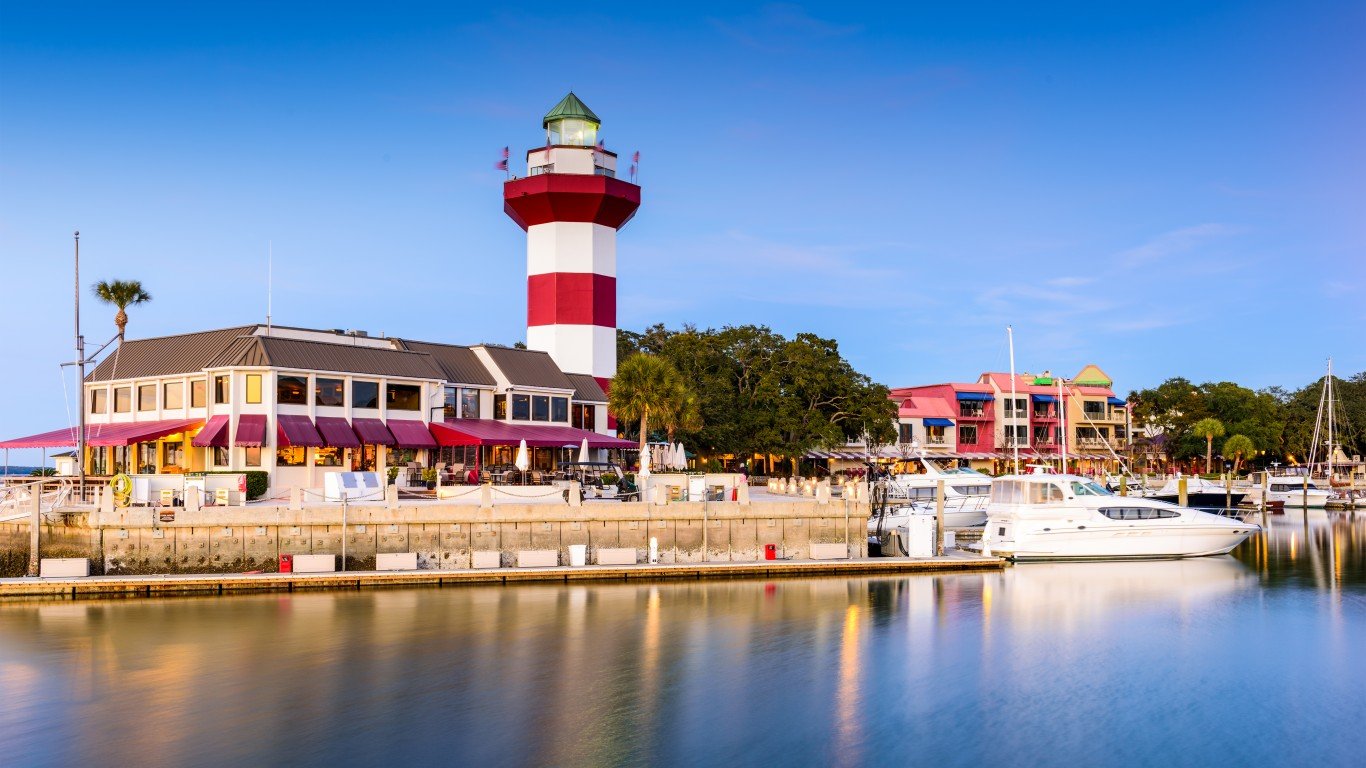
South Carolina: Hilton Head Island-Bluffton
> Adults with a bachelor’s degree: 38.0% (state: 29.6%)
> Median household income: $71,252 (state: $56,227)
> Number of college and universities: 2
The Hilton Head Island-Bluffton metro area is the best educated of South Carolina’s eight metro areas, with a bachelor’s degree attainment rate of 38.0%. To compare, fewer than 30% of South Carolina adults hold a four year degree.
The Hilton Head Island-Bluffton metro area, at South Carolina’s southern tip, is not just the best educated part of the state, but also the wealthiest. Area residents typically make about $15,000 more annually than those in South Carolina overall.

South Dakota: Sioux Falls
> Adults with a bachelor’s degree: 34.6% (state: 29.7%)
> Median household income: $65,566 (state: $59,533)
> Number of college and universities: 8
Just over a third of Sioux Falls adults 25 and older have at least a bachelor’s degree, a slightly higher share than the attainment rate in Rapid City, the only other major metro area in South Dakota. Individuals with a college degree are more likely to hold advanced, high-paying jobs and to have higher incomes than those with less educational attainment. In Sioux Falls, the typical household has an income of $65,566 a year, more than the median household income in Rapid City of $58,361 and the median of $59,533 in South Dakota as a whole.
[in-text-ad]

Tennessee: Nashville-Davidson–Murfreesboro–Franklin
> Adults with a bachelor’s degree: 38.5% (state: 28.7%)
> Median household income: $70,262 (state: $56,071)
> Number of college and universities: 56
Nashville, the capital of Tennessee, is also the best educated city in the state. It is the only metro area of the 10 in the state where more than one in every three adults have a bachelor’s degree or higher. In Knoxville, the second best educated city in the state, only 29.9% of adults have a four-year degree.
Though those with a college education are less likely to be unemployed, Nashville residents are more likely to be unemployed than those in Tennessee as a whole, likely due in part to the area’s high reliance on tourism, an industry hard hit by the pandemic. As of July 2020, the Nashville area’s unemployment rate stood at 9.6%, compared to 2.7% two years before.

Texas: Austin-Round Rock-Georgetown
> Adults with a bachelor’s degree: 46.2% (state: 30.8%)
> Median household income: $80,954 (state: $64,034)
> Number of college and universities: 37
Austin is by far the best educated metro area in Texas, with over 46% of adults holding at least a bachelor’s degree. The next closest metro area has a 38.0% bachelor’s degree attainment rate.
The Austin area is the best educated place in Texas for a number of reasons, including being home to one of the nation’s largest schools, the University of Texas at Austin. As the state capital, it also employs lawmakers and other government workers, many of whom are college educated. And with major tech companies like Dell, IBM, Apple, AT&T, and more operating in Austin, the area further attracts well-educated workers.

Utah: Provo-Orem
> Adults with a bachelor’s degree: 40.6% (state: 34.8%)
> Median household income: $79,152 (state: $75,780)
> Number of college and universities: 16
While there are many U.S. cities with high bachelor’s attainment rates and relatively low shares of adults with a high school diploma, high school and college educational attainment rates tend to be correlated. In Provo-Orem, 95.6% of adults have a high school diploma, the highest share in the state and the 11th highest among all U.S. metropolitan statistical areas.
[in-text-ad-2]

Vermont: Burlington-South Burlington
> Adults with a bachelor’s degree: 44.6% (state: 38.7%)
> Median household income: $74,909 (state: $63,001)
> Number of college and universities: 5
The Burlington-South Burlington metro area is the only metro area in Vermont and ranks as the most educated city in the state by default. In this case, it is also deserving of the title as 44.6% of metro area adults hold at least a bachelor’s degree, among the highest bachelor’s degree attainment rates in the country. Burlington area residents likely have a high standard of living as the median household income of nearly $75,000 annually is about $12,000 higher than the national median. Similarly, the area’s 7.5% unemployment rate is well below the state and national rates for July 2020.

Virginia: Charlottesville
> Adults with a bachelor’s degree: 49.2% (state: 39.6%)
> Median household income: $75,907 (state: $76,456)
> Number of college and universities: 3
Charlottesville is the best educated metro area in Virginia and one of the best educated nationwide. Of all adults in the metro area, 49.2% have a bachelor’s degree or higher, well above the 39.6% share of adults in Virginia and the 33.1% of adults nationwide. Many of the metro areas on this list are home to major research institutions and universities, and Charlottesville is home to the University of Virginia.
[in-text-ad]

Washington: Seattle-Tacoma-Bellevue
> Adults with a bachelor’s degree: 44.1% (state: 37.0%)
> Median household income: $94,027 (state: $78,687)
> Number of college and universities: 64
Some 44.1% of adults 25 and older in the Seattle metro area have at least a bachelor’s degree, the largest share in Washington and the 26th largest share nationwide. One factor attracting college graduates to the Seattle metro area is likely the presence of major tech companies such as Amazon and Microsoft. These companies are among the highest-paying in the nation, likely driving up the area’s high median household income. The typical Seattle household earns $94,027 a year, far more than the $78,687 median household income for Washington as a whole. There are also dozens of major universities in the region.
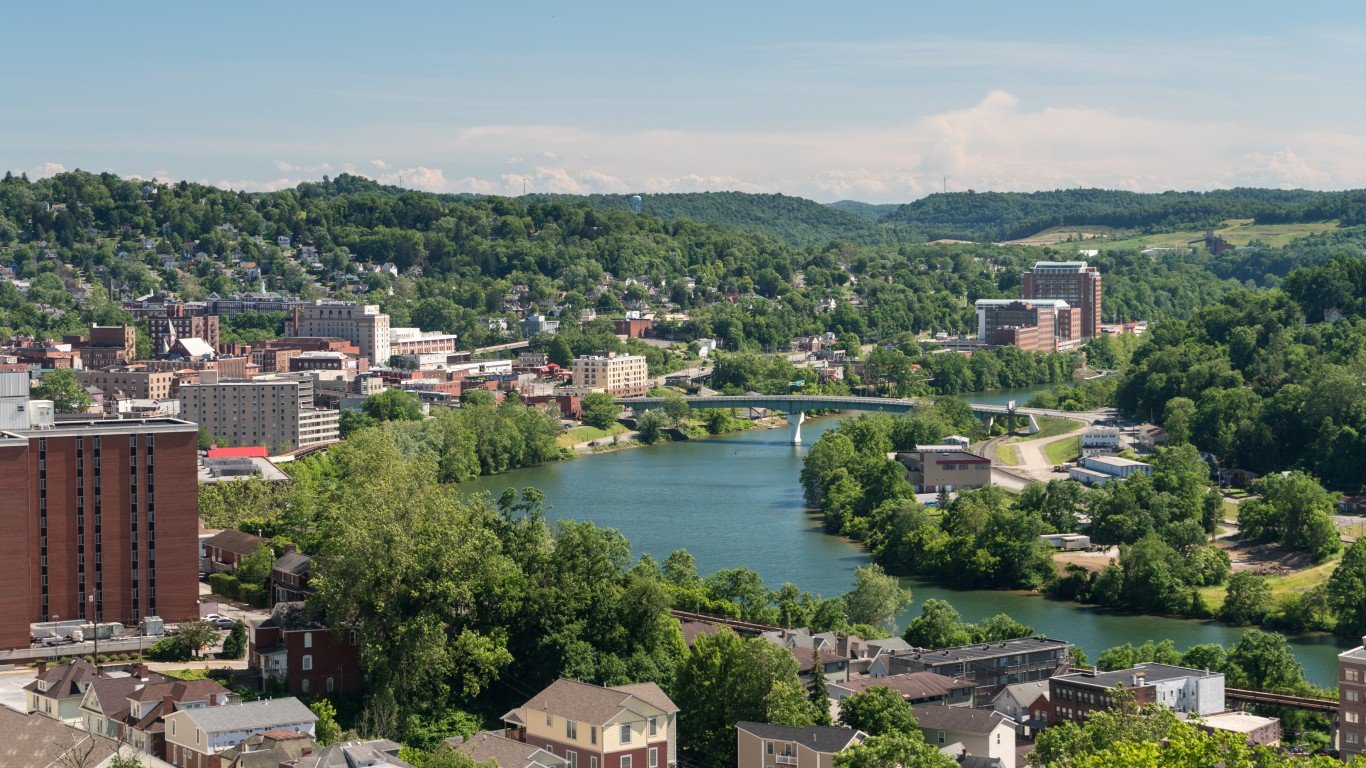
West Virginia: Morgantown
> Adults with a bachelor’s degree: 37.9% (state: 21.1%)
> Median household income: $56,395 (state: $48,850)
> Number of college and universities: 6
West Virginia is the least educated state in the country. Just 21.1% of adults in the state have a bachelor’s degree or higher, well below the 33.1% share of adults nationwide. Not all parts of the state have low educational attainment, however. In Morgantown, 37.9% of adults have a bachelor’s degree, a larger share than in the vast majority of metro areas nationwide.
Major research universities typically have large graduate student populations and employ highly-educated instructors, and partially as a result, college towns often have relatively well-educated populations. Morgantown is home to West Virginia University.
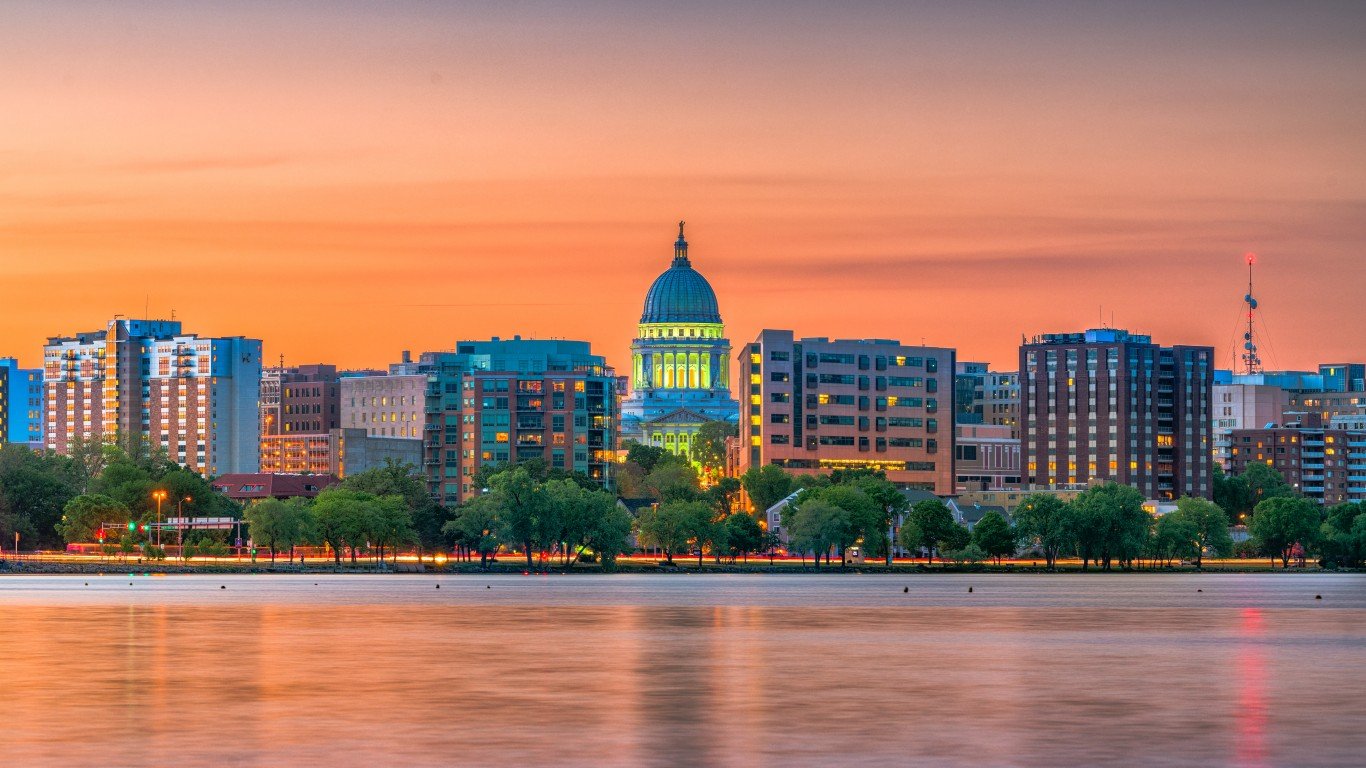
Wisconsin: Madison
> Adults with a bachelor’s degree: 48.6% (state: 31.3%)
> Median household income: $75,545 (state: $64,168)
> Number of college and universities: 16
Madison is the only one of Wisconsin’s 12 metro areas where over 40% of adults have a bachelor’s degree. The 48.6% bachelor’s degree attainment rate in the metro area is not only the highest in the state, but also among the highest in the country and well above the 33.1% national rate. As is the case with many metro areas on this list, Madison is a college town. The metro area is home to the University of Wisconsin, by far the largest postsecondary institution in the state by enrollment.
[in-text-ad-2]

Wyoming: Cheyenne
> Adults with a bachelor’s degree: 30.1% (state: 29.1%)
> Median household income: $70,567 (state: $65,003)
> Number of college and universities: 3
Wyoming is home to two metro areas, Cheyenne and Casper. Cheyenne’s college attainment rate of 30.1% is higher than Casper’s, where 20.7% of adults have a bachelor’s degree, yet it is still lower than the 33.1% national college attainment rate.
Individuals with a college degree are more likely to have advanced, high-paying jobs and to have higher incomes than those with less educational attainment. While Cheyenne has a higher college attainment rate than Casper, the median household income in the Wyoming capital is actually lower. The typical household in Cheyenne has an income of $70,567 a year, compared to a median household income of $65,034 in Casper.
Methodology
To identify the most educated city in every state, 24/7 Wall St. reviewed the bachelor’s degree attainment rate — the percentage of metro area adults who have earned at least a bachelor’s degree — in every state. The bachelor’s degree attainment rate and high school diploma attainment rate, along with median household income for metro areas and states all came from the U.S. Census Bureau’s 2019 American Community Survey.
Shares of each metro area’s workforce employed in particular industries came from the Bureau of Labor Statistics. Unemployment figures are also from the BLS and are for July 2020. The number of postsecondary institutions in each metropolitan area came from the U.S. Department of Education. Postsecondary institutions include four-year and two-year universities and colleges as well as technical institutes and trade academies.
The Washington-Arlington-Alexandria metro area, which spans the District of Columbia, Virginia, Maryland, and West Virginia, was excluded from the ranking.
Sponsored: Attention Savvy Investors: Speak to 3 Financial Experts – FREE
Ever wanted an extra set of eyes on an investment you’re considering? Now you can speak with up to 3 financial experts in your area for FREE. By simply
clicking here you can begin to match with financial professionals who can help guide you through the financial decisions you’re making. And the best part? The first conversation with them is free.
Click here to match with up to 3 financial pros who would be excited to help you make financial decisions.
Thank you for reading! Have some feedback for us?
Contact the 24/7 Wall St. editorial team.
 24/7 Wall St.
24/7 Wall St. 24/7 Wall St.
24/7 Wall St.


